- Tourism Watch
- The Dark Sides of tourism in the Maledives


The Dark Side of Life
Maldivians marginalized in the Maldives
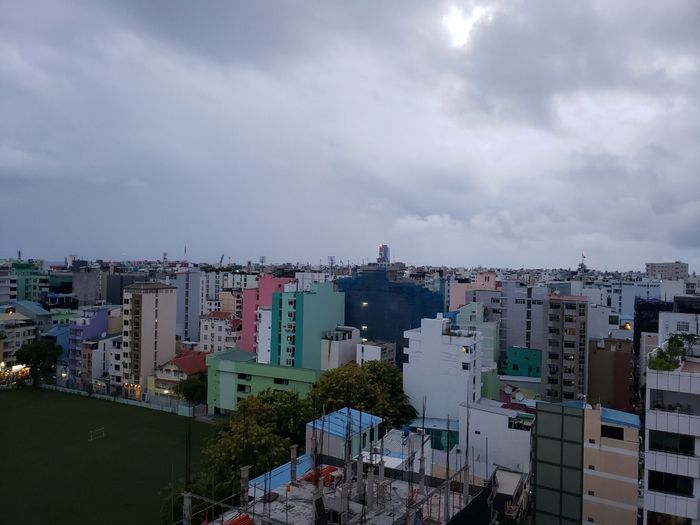
In the Maldives, the tourism industry is touted as the goose that lays golden eggs. According to the World Bank, the Gross Domestic Product (GDP) per capita ballooned from 600 USD in 1985 to over 9,000 USD by 2017. The nation graduated from one of the 20 poorest countries in the world in 1980 to a middle income country by 2017. A quarter of the overall GDP comes from tourism. While the country got rich, the majority of the population got poor in comparison. Centralization policies and the excessive tourism development on uninhabited islands benefit only a chosen few.
Centralization on Male’
The Maldives consists of more than 1200 islands - 188 of them are inhabited – stretching over more than 750 kilometres. Fifty years ago, inhabitants of the islands in the north and south were living a prosperous life based on agriculture and fishing. Raw materials for agricultural products were collected from forest areas of inhabited islands as well as uninhabited islands nearby. Direct trade with neighbouring countries flourished. Common goods exported included coir rope, coconut, and other agricultural products as well as value added items made from fish, such as dried or salted fish. However, halting of direct trading activities from various islands to foreign countries due to centralization of commerce and transport in Male caused decline of local agriculture and fish processing based on a vibrant small holder industry, leading to loss of livelihoods – particularly for women and youth.
Crowded Capital
At the same time, the government started to develop tourism in uninhabited islands close to Male’ and to centralise basic services in the capital. This paved the way for development induced migration in the search of jobs, education and health services. The exodus of natives to Male’ emptied some of the biggest islands, such as Hithathdoo in Addu atoll. While 100 years ago, only 9 percent of the population lived in the capital, today 38 percent reside there. The tiny island with barely 2 km2 in size is crammed with more than 130,000 inhabitants.
Report after report gets published on socioeconomic problems created especially in Male’. With a population density of 65,201 per km according to National Bureau of Statistics of Maldives, Male’ is the place where the Maldivian Dream comes to die: The dream of living in dignity with your family in your home island doing productive work and contributing to prosperity of your community and its people, the dream of quality of life as enjoyed by the tourists occupying many prime beaches, islands, lagoons and sandbanks. The natural resources and their beauty are fast becoming a privilege for tourists.
Benefits for a chosen few
The allocation of land including declaring uninhabited islands for resort development remains with the head of state. The laws introduced for open and more transparent bidding were reversed in 2016 to allow closed bidding again ensuring the industry is back to its old undemocratic ways. Hence ownership of resorts mostly rests with elites and executive faction of society that mainly resides in Male’ and overseas. Successive governments keep on amending laws, to benefit tourism tycoons, giving most islands in Male’ and nearby atolls to tourism. From 970 uninhabited islands in the Maldives 304 islands have been allocated to tourism, as of 2018. Be it children’s playground like Feydhoo Finolhu or the local picnic island like Kuda Bandos in Male’ atoll, the government gave them all with little consideration of the needs of locals, their wellbeing, their food security, as well as cultural and social rights. The tourism industry provides very little income opportunities for Maldivians – it has restored to employing foreigners which account for 58 percent of resort employment as per latest census data.
Needs of the residents
What the island communities in Maldives are asking is simple: Stop land grabbing! Stop reclaiming lagoons for profit purposes! Do not give all uninhabited islands to tourism. Stop killing marine life, stop killing our source of food. Give us back our livelihood. Let us invest in food security, do not steal our picnic islands. Leave something for the birds; leave something for the fish to breed. Preserve and protect these resources for future generations! Is this too much to ask?
The new coalition government of Ibrahim Mohamed Solih has promised to empower island communities by allocating part of the revenue generated within the atolls to island councils as well as giving the jurisdiction of land and nearby uninhabited islands to councils. However, the task of correcting past wrongs like freeing some islands for community use in atolls will not be easy. As long as the same big businessmen that control these islands also sit in the parliament and resist fair distribution of natural resources. A redistribution policy that benefits the natives is crucial for sustainable develo pment in the Maldives.
Muna Mohamed is a Maldivian author and a blogger on forced migration, land grabbing, and management of natural resources for sustainable development to safeguard rights of communities.
Infoservice
The most important backgrounds every two to three months
- REAL ESTATE
- HOSPITALITY
- Hospitality
Weighing the Downsides of Tourism Dependence in the Maldives
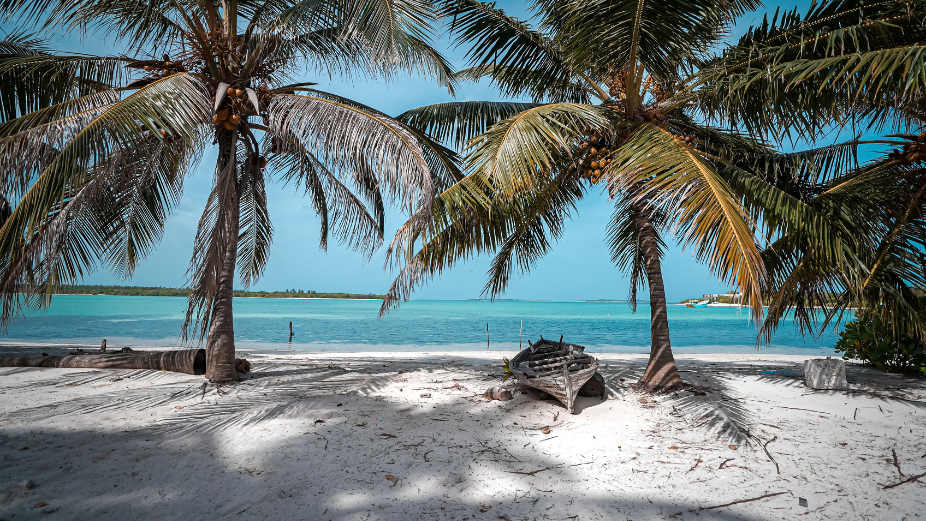
While the tourism sector plays a critical role in the global economy, an over-dependence on it can pose substantial challenges, especially for smaller nations like the Maldives, where tourism is the predominant support for their GDP.
Economic Challenges
Nations heavily dependent on tourism face economic challenges, particularly vulnerability to fluctuations in tourism numbers due to factors like natural disasters, political unrest, or health crises. The Maldives, for example, despite welcoming tourists early during the pandemic, witnessed a notable decline in their GDP.

Additionally, a surge in tourist numbers can drive up local prices. This heightened demand might raise the cost of living, affecting the quality of life for the locals. Although local island tourism, such as guesthouses, brings substantial revenue, it can also lead to increased prices in local shops.
Seasonal Volatility
Tourism’s seasonal nature means inconsistent revenues. Such variability can strain businesses and workers, leading to financial unpredictability. In off-peak periods, resort occupancies tend to drop sharply due to reduced tourist arrivals.
Environmental Impact
Overpopulated tourist destinations can encounter environmental issues. The ramifications include increased waste, degradation of sites, and disruptions to local ecosystems. Several reclamation projects in the Maldives, intended for tourism expansion, have inflicted permanent damage on lagoons and their adjacent areas. Catering to the ever-growing tourist demand has sadly compromised the Maldives’ delicate ecosystem.
The Path Ahead: Embracing Diversification
The solution appears to lie in diversification. By investing in sustainable industries such as renewable energy, technology, and sustainable agriculture, reliance on tourism can be mitigated. Branching out into manufacturing or other service sectors might also counterbalance the heavy dependence on tourism. The Maldives already champions sustainability. The question remains: Can they broaden this commitment?
While tourism offers profound economic benefits, it’s important to understand the downsides of over-reliance. An economic diversification strategy can promote stability, safeguard the environment and cultural identity, and present a broader spectrum of opportunities for the nation’s inhabitants.
RELATED ARTICLES MORE FROM AUTHOR

Simdi Ramadan Promotion 2024 Week 4 Lucky Draw Winners Announced
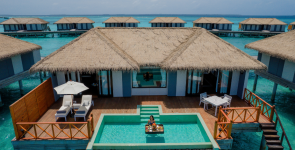
China Remains Dominant Force in Maldives Tourism
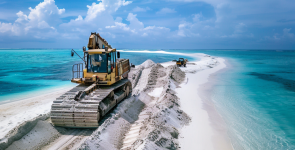
Gov’t Eases Restrictions on Sand Mining Near Protected Areas

STELCO Launches “Eid Ali” Initiative to Illuminate Maldives for Fitr-Eid

Cosmopolitan Maldives Introduces Hardys ZERO Alcohol-Free Wines
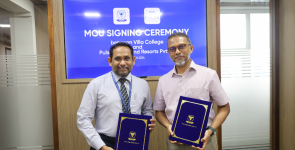
Villa College and Pulse Hotels and Resorts Forge Educational Partnership
Latest articles.


Dependence on tourism devastates Maldives; need to look for sustainable revival strategy
India’s timely help to the maldives is not without detractors, especially the political opposition that has been protesting the presence of the indian military, writes n chandra mohan for south asia monitor.

Like the rest of South Asia, the Maldives, too, have been adversely impacted by the economic fallout of COVID-19. This small archipelagic island country’s output of goods and services or GDP is projected to shrink by a massive 30 percent this year, according to Fitch Ratings, because of its dependence on tourism that has had to shut down to battle the viral pandemic.
Tourism accounts for 56.6 percent of its GDP, 59.6 percent of employment and 48.5 percent of the government’s revenues excluding grants, according to the World Bank. The hit to the exchequer due to COVID-19 will be known when the USD 2.5 billion budget is presented on November 9. Tourist arrivals have gradually picked up since borders reopened in mid-July.
Tourism - the mainstay of the economy
International commercial flights have resumed. The first air bubble arrangement in South Asia was created by India with the Maldives on August 13. Single weekly direct flights of India’s national flagship carrier Air India to the Maldives have begun from Thiruvananthapuram, the capital of Kerala state. Around 37, 468 tourists visited the island nation between mid-July and October 28, while 100,000 arrivals have been targeted by the year-end.
“The Maldives needs tourism. When tourism stops, everything stops,” bluntly stated Maldives’ Tourism Minister Dr. Abdullah Mausoom.
However, a sustainable rebound in tourism is an iffy proposition and is predicated on a virus containment strategy that will encourage more footfalls. The bad news in this regard is that infections are surging domestically. Maldives’ Health Emergency Operations Centre recently confirmed a significant number of COVID-19 cases in the resort island of Kandima in the Dh Atoll despite stringent health measures in place and schemes like ‘one island one resort’ to encourage socially distanced vacations.
The pandemic thus poses serious challenges to the government’s drive to kick-start tourism to boost overall economic growth. The Maldives’ economic condition thus is fragile and needs assistance.
India's timely economic help
The prompt response from the neighbourhood in this regard is indeed noteworthy. India, with whom it shares long-standing ethnic, linguistic, cultural, religious, and commercial links, loosened its purse strings to provide timely budgetary assistance and generous lines of credit to help build its infrastructure and cope with COVID-19.
In his address to the SAARC (South Asian Association for Regional Cooperation) foreign ministers' meeting, Maldives’ Foreign Minister Abdulla Shahid acknowledged that the USD 250 million pledged by India as the largest support package announced by a bilateral partner during COVID-19.
To be sure, India responded in the past as well to help the Maldives, especially during the coup attempt in 1988, the Tsunami of 2004, and the drinking water crisis in 2014.
When COVID-19 struck, India sent in rapid response medical teams and supplied essential medicines through Operation Sanjeevani. Financial assistance of USD 250 million provided in September was through investments by the State Bank of India in Maldives government bonds on concessional terms. A currency swap of USD 150 million was approved by the Reserve Bank of India to help the Maldives - all of which will help it to deal with the economic crisis inflicted by the virus.
India is also the single largest donor of Maldives with USD 1.4 billion received in 2018 and cash grants for various community projects.
At a bilateral meeting of foreign ministers in August, India’s External Affairs minister S Jaishankar extended a fresh line of credit of USD 400 million and a grant of USD 100 million to help build a sea bridge to connect three islands with the capital Male, which will generate employment and strengthen the economy. India’s foreign secretary Harsh Vardhan Shringla is expected to visit Maldives on November 9-10 and is bound to follow up the progress on all these projects.
However, India’s timely help to the Maldives is not without detractors, especially the political opposition that has been protesting the presence of the Indian military. Its aid is transparent and serves the developmental interests of Maldives. With regard to the infrastructure project linking Male to three islands, for instance, the Maldivian finance ministry announced how 65-70 percent of components will be sourced by India, facilitating participation by the Maldivian businesses and services.
Time to plan for the future
There will also be an international tendering process for the contract, according to N Sathiya Moorthy of the Observer Research Foundation. The budget will clearly indicate how the island nation will cope with the ravages of COVID-19. With around 22,000 Maldivians left without jobs, extending monthly income support for some more time is imperative. If the spread of the virus cannot be checked, tourist arrivals will taper off and recessionary conditions will persist.
Looking into the future, a more sustainable revival strategy would be to diversify away from the dependence on a single industry. Saline soil conditions and scarcity of arable land limit the possibilities in agriculture.
Participating in labour-intensive manufacturing activities for exports to the world market perhaps can be explored by improving local skills.
(The writer is an economics and business commentator based in New Delhi. The views expressed are personal. He can be contacted at [email protected])
Related Posts
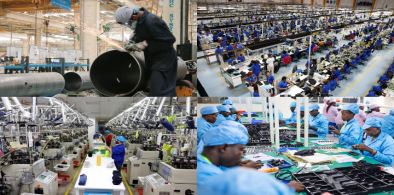

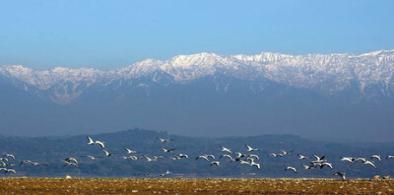
Post a Comment
Sugeeswara Senadhira, Advisor (Media & International Affairs) to Sri Lanka’s Prime Minister Dinesh Gunawardena speaks with Mayank Chhaya on India, Sri Lanka & #Katchatheevu | SAM Conversation

Aparna Rawal, specialist on the AfPak region speaks with Col Anil Bhat (retd.) on Pakistan's growing security challenges on its western border and Indian defence minister's offer for the first time to help Pakistan counter terrorism | SAM Conversation

Frank Islam speaks with Irtif Lone, a startup ecosystem builder in Jammu and Kashmir, India on the region's growing entrepreneurshp culture | Washington Calling

Frank Islam speaks with Mateen Haider, Islamabad-based analyst and anchor on the Pakistan situation post elections | Washington Calling

In Indian capital, Muslim home cooks stir up a culinary revolution | Reimagining India

Transwomen serve inclusion on a plate

Gandhi, 1918 flu pandemic and COVID19

Faith and judiciary: A case from Pakistan

Geetanjali Shree first Indian to win International Booker Prize: Will it open doors for translations of great literature in all Indian languages?
Newsletter Subscription

The changing face of tourism and work: How Maldives is successfully adapting to the pandemic
Valerie mercer-blackman.

It’s December 2023. Rita, a young businesswoman, has just finished meeting with clients in Chennai, India and anticipates meeting friends in Singapore for the holidays two weeks later. An employer-sponsored hybrid work model allows her to work from anywhere. She chooses to work at a guesthouse in Male, Maldives thanks to great Internet connectivity while spending time absorbing the local culture and South Asian cuisine, even trying her hand at snorkeling. Pre-COVID-19, she would have had to fly back from Chennai, India to snowy Chicago where she resides; go to the office for 10 days; work fighting an arduous jetlag; and then fly back East almost 10 thousand miles to Singapore. Now not only is she significantly reducing her carbon footprint, but she also feels revitalized after her stay in the Maldives, and is happier and more productive. Not to mention, she has contributed to Maldives’ tourism industry.
Is Rita’s practical yet creative twist on work-life balance indicative of the future of tourism—and work?
According to various measures in the World Bank’s latest South Asia Economic Focus (SAEF), the region’s tourism heavy nations—Maldives, and to a lesser extent Nepal, Sri Lanka, and Bhutan—are well poised to take advantage of new services and digital technologies along with a new-found need for wellness post-pandemic, to boost their economies . See a prior blog on services as the driver of development in South Asia.
Tourism: Savior for a Post COVID Economy?
Before COVID-19, tourism was among the fastest-growing sectors in Maldives and Bhutan, with a growth rate that outpaced GDP growth rates. The pandemic and related stringent measures hit all South Asian countries dependent on tourism hard, leading to a deep contraction in GDP in 2020. According to the World Travel and Tourism Council , the entire global tourism industry, particularly business travel, was devastated by the pandemic. Business spending decreased by 61 percent from 2019 to 2020 compared to 49 percent for leisure travel. Business travelers on average spend much more than leisure and domestic travelers, making the recovery of business spending essential for the entire travel sector. As the industry struggles to recover, there is also great uncertainty about how the future of work could transform the demand for travel, and many expect international business travel to be the last segment to recover as it is most sensitive to travel restrictions.

However, despite these uncertainties, our analysis in the South Asia Economic Focus shows that tourism has the potential to be a fast-growing sector post-COVID amidst new remote work possibilities and changing travel behaviors:
- The desire for travel is strong, spurred by the pent-up demand in leisure travel, which has been driven by new hybrid work environments and household savings during the pandemic.
- As remote work becomes a long-term reality, more than half of the global tourists have expressed interest in extending business trips or working remotely in tourism destinations while enjoying leisure time.
- There is also evidence of an increase in the average duration of stay by 2.4 days since 2020, according to Tourism Status Updates by the Ministry of Tourism Maldives.
- The ravaging effects of COVID-19 on mental health may also increase the demand.
- COVID-19 is changing tourists’ attitudes and behaviors. According to recent online surveys by booking.com , more than half of global travelers, particularly younger travelers, started looking for travel plans that were more sensitive to the environment and local communities, including staying away from crowded tourist attractions and exploring lesser-known destinations.
South Asian countries already have a comparative advantage in developing niche tourism and ecotourism, as they are endowed with diverse natural and cultural resources. Therefore, small and tourism-dependent countries can view the pandemic as an opportunity to unleash the potential of tourism and pave the way for sustained growth going forward.
Maldives: Setting the Bar High in Tourism
Maldives has been exemplary in its resilience and ability to recover. In 2021, visitor arrivals reached more than 80 percent of pre-COVID levels, far outpacing other similar tourist destinations.
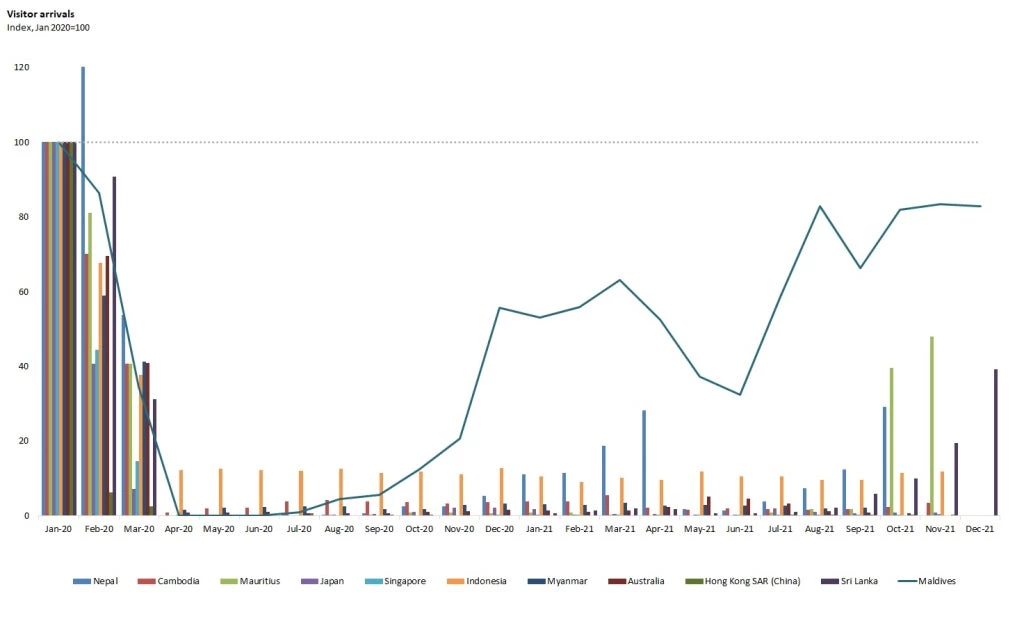
These are some lessons we can draw from Maldives’ spectacular recovery in the tourism sector:
- First, the government’s policies and interventions around the border restrictions and health regulations play an important role in the recovery of the tourism sector. For example, Maldives took a concerted effort to reopen its border to tourists as early as July 2020 but implemented strict hygiene protocols for tourists, including one of the fastest COVID-19 vaccination campaigns in the world. This has improved the confidence of travelers and has created high-value consumers.
- Second, Maldives quickly made an effort to capture new source markets and expand to new countries of origin. For example, the emerging source of the international tourist market from Russia and India—in part arbitraging quarantine rules—has compensated for the tourism revenue loss from China, its top source market before the pandemic.
- Third, Maldives is seizing changing preferences to promote a better image. In 2020, Maldives launched a marketing campaign with the tagline “ Isolation never looked this good ” to emphasize its unique reputation of being a niche destination, while emphasizing environmentally sustainable tourism.
- Fourth, it is investing in digital technology as the demand for high-speed internet and contactless services rise due to the pandemic. In Maldives, more than 60 percent of the population has access to broadband Internet—with relatively high bandwidth speed—while other tourism-dependent South Asian countries are still lagging , limiting the possibilities to meet travelers’ need for working remotely. Moreover, digital platforms will be important in minimizing physical interaction when traveling, while still fulfilling travelers’ needs. For example, one of the luxury resort in Maldives, has developed an app to facilitate contactless services including ordering food, virtual check-in and check-out, and other amenities to adapt to changing customer behaviors.
Adapt or perish? Maldives is choosing the former. It behooves other South Asian nations to pay attention as they build back resiliently post COVID-19.
- Digital Development
- COVID-19 (coronavirus)

Lead Economist
Join the Conversation
- Share on mail
- comments added

The World Bank In Maldives
A partner of the World Bank since 1978, Maldives has been a development success story of sustained growth and impressive improvements in health and education. The country faces a number of environmental, climate, and inclusion challenges that we're working together to help address.
- Country Context
At a Glance
Maldives, a country of around 550,000 people dispersed across 185 islands, is an upper-middle-income country with a robust growth trajectory. The economy has maintained its strong growth momentum in 2023 due to rising tourist arrivals, and, with rising tourist arrivals, is expected to maintain a strong growth and poverty reduction trajectory. Overall, sustained growth performance in the last decade has significantly reduced poverty, and Maldives performs well on poverty outcomes compared to its regional, income, and small island peers. The economy is heavily dependent on tourism which has been the main driver of economic growth in Maldives and the dependence on tourism makes the country highly vulnerable to macroeconomic and external shocks. Commodity price volatility is exerting pressure on external and fiscal balances, through costlier imports and higher subsidies. In addition, existing high debt stock of the public sector, elevated levels of spending the government’s aim to undertake sizeable infrastructure investments through external non-concessional borrowing, and the presence of blanket subsidies for major consumption items have led Maldives to be exposed to elevated fiscal vulnerabilities. Public debt is expected to remain high, warranting continued efforts to reduce fiscal deficits, including comprehensive subsidy and public investment management reforms while mitigating impacts on the vulnerable.
Key Conditions and Challenges
Tourism, which accounts for almost one-third of the economy, has maintained its robust growth performance in the first half of 2023. Despite the Russian invasion of Ukraine, arrivals from Russia remain strong. An earlier-than-expected reopening of the Chinese market in January has compensated for fewer tourists from India and Gulf countries, while arrivals from Europe remained high. This supported employment opportunities, which are particularly important for the poorest. However, heavy reliance on tourism and limited sectoral diversification remain key structural challenges as Maldives is highly vulnerable to macroeconomic shocks.
As an economy that is heavily import-dependent, Maldives is facing significant external and inflationary pressures due to the sharp rise in global commodity prices. This is negatively affecting public finances given the government’s blanket provision of subsidies to help contain domestic price increases. This is further compounded by continued high capital expenditure and public debt, an increasing wage bill, and a costly health insurance scheme. Targeted austerity measures could mitigate risks to vulnerable households, particularly in the atolls, where 93 percent of the poor live, as past welfare gains have been driven by a strong redistributive model. The latter includes universal access to basic health and education services, pensions, health insurance, and income support programs – which contribute to a larger share of income for poorer households. Additional challenges to welfare include differential access to economic opportunities in Male relative to atolls – mirrored by a higher Gini index over the whole population (29.3) than within Male (25.2), higher vulnerability among the self-employed, and overcrowding affecting poorer urban households.
To promote development, Maldives has scaled up infrastructure investments since 2016. Although these investments have contributed towards growth and better living standards, financing of these large investments through non-concessional sources has led to growing debt vulnerabilities. Despite an increased cost of external borrowing, the government continued to use foreign financing for infrastructure investments in 2023, while also relying on domestic borrowing to support recurrent spending. This has led to a concerning rise in the financial sector exposure to the sovereign. The debt stock and debt servicing risks are expected to remain high in the medium term.
Recent Economic Developments
The economic growth, in real terms, was 13.9 percent (y-o-y) in 2022, followed by a 5.5 percent (y-o-y) in Q12023. The robust growth performance has led to a higher income than the pre-pandemic level, translating into projected poverty rates below 2019 levels Tourist arrivals reached 1.2 million by August 2023 and are projected at 1.9 million in 2023 – 13.8 percent higher than in 2022. However, along with the Goods and Services Tax (GST) increase in January 2023, higher global commodity prices led to rising domestic inflation, which reached an average of 3.5 percent (y-o-y) in H12023 – higher than the historical average of 0.5 percent. Price increases were particularly acute in the food -climbing to 8.0 percent in March before falling to 4.5 percent in June-, transport, health, and restaurant services sectors.
Despite growth in tourism earnings, the current account deficit doubled to 16.5 percent of GDP in 2022, due to far costlier oil imports and capital imports for large investment projects. High import costs and external debt repayments put significant pressure on gross reserves, which fell from US$790 million in January to US$594.1 million in July (from 2.8 to 2.0 months of imports).
Public finances remain under pressure. Given subsidy reforms were not implemented and capital spending cuts have not happened – both of which were proposed in the 2023 Budget – spending rose in 2023. However, this was somewhat offset by higher tax collections owing to the robust growth and increased tourism GST. Consequently, the 12-month rolling fiscal deficit declined in May to an estimated level of around 11 percent of GDP compared to 14.2 percent in 2022. MMA’s asset exposure to government further rose to 52 percent of its total financial assets at mid-2023, from 47.3 percent in 2022.
Outlook, Risks, and Challenges
The economy is projected to grow by 5.6 percent on average in the medium-term, supported by robust tourism performance. The return of Chinese tourists, together with increasing arrivals from new and existing markets are expected to lead to sustained growth. Tourism will further be supported by the expansion of Velana International Airport (planned to be completed by 2025), a diversified tourism sector, and investments in new resorts.
Despite the recent increase in GST collections, in the absence of fiscal reforms, any meaningful improvement in the fiscal balance will be offset by continued high levels of spending. Public debt will, therefore, remain high. A larger fiscal adjustment is required to build external buffers and reduce fiscal vulnerabilities, including reducing spending on untargeted subsidies and bulk procurement for pharmaceutical purchases, and more effective public investment management. Better targeted transfers – including redirecting inefficiently allocated resources– would help mitigate the negative impacts of subsidy reforms on the poor.
High levels of consumption, elevated global commodity prices, and the GST rate hike are projected to keep inflation above the historical average in the medium term. Without targeted support, higher prices passed onto households could worsen the poverty outlook. Therefore, future subsidy reforms need to be carefully designed to minimize welfare risks.
The current account deficit is expected to remain elevated. High commodity prices and necessary capital imports driven by the government’s ambition to complete ongoing and planned infrastructure projects and commence projects in outer Atolls are expected to lead to a high current account deficit over the medium-term. Volatile oil prices and rising external financing needs – including debt servicing – are expected to sustain pressure on official reserves.
Downside risks persist. Tourism could be adversely impacted by an extended global slowdown. Any further widening of current account deficit could put additional pressure on reserves. Government faces external debt servicing payments of US$570 million on average over the next two years amidst tighter global financing conditions. On the upside, the global tourism sector outlook is robust, and with strong economic growth, poverty rates are expected to decline.
Reforms are needed to improve the fiscal outlook and ensure debt sustainability. More effective revenue mobilization measures, coupled with reforms to Aasandha national health insurance scheme and existing subsidy programs, and better investment management are critical to bring down the high level of public debt, replenish fiscal buffers against future shocks, and lower the cost of growth-enhancing investments, especially with large debt service obligations coming due in 2026.
Last Updated: Oct 04, 2023
World Bank Program in Maldives
Maldives became a member of the World Bank in 1978 and has enjoyed a trusted partnership with the institution over the past 44 years. Working together, the country has implemented various projects in support across many development areas.
Maldives has an active portfolio of 12 projects – 11 International Development Agency (IDA) projects, 1 IDA guarantee and 1 regional project – with a total net commitment of $258 million. The projects are focused on fisheries, solid waste management, renewable energy, employment and social protection, urban development, COVID-19 response, digital development, youth resilience, health systems, and financial management.
The World Bank also provides analytical support in macro monitoring and analysis, financial sector, youth and gender, health financing, social protection, and poverty.
The World Bank’s new Country Partnership Framework (2023-2027), adopted in January 2023, aims to help the Maldives navigate through risks and vulnerabilities to reach a greener, more resilient, and inclusive high-growth future. Under the new CPF, the World Bank’s engagement with the Maldives focuses on improving resilience to shocks, increasing access to economic opportunities, and improving human capital outcomes. Deepening the digital economy, to accelerate economic transformation, is also a cross cutting theme.
IFC Collaboration
Maldives joined the International Finance Corporation (IFC), in 1983. Since then, IFC has invested nearly $250 million. Currently, the portfolio in Maldives is $53 million with commitments in Dhiraagu, Bank of Maldives (BML) and Housing Development Finance Corporation (HDFC).
In response to the COVID-19 crisis and in line with its strategic priorities in Maldives, IFC had pivoted resources to support key sectors adversely impacted by the pandemic. At the request of the Government, and in line with IFC’s countercyclical role, support to the Maldives with liquidity access was provided in the early stage of the pandemic. IFC’s investment of $50 million in BML provided financing for private sector companies and small and medium sized businesses in the tourism sector, to help preserve jobs and combat the negative shocks of COVID-19 on the economy. IFC also invested over $50 million directly in the tourism sector in FY20 via its investment in John Keels Holdings and $22.4 million through the Crescent Fund in FY23. Further, a $35 million landmark investment in Dhiraagu (in FY22/23), the largest telecommunications and digital service provider in the country, is helping Maldives digitize faster.
IFC’s strategy for FY21-25 in Maldives revolves around 3 pillars: sustainability, inclusion, and connectivity anchored by the tourism sector. IFC is committed to helping the Maldives achieve its ambitious target of net-zero emissions by the year 2030 through sustainable growth by increasing the use of renewable energy, further greening resorts, building climate resilient infrastructure, and enhancing sustainable waste management. Physical and digital connectivity also remain key strategic priorities along with accelerating SOE reforms. Achieving these strategic priorities will require close collaboration with the World Bank. IFC is also actively seeking to partner with other DFI’s, specifically to mobilize financing to further strengthen the Maldivian economy.
Supporting COVID-19 response: The COVID-19 Emergency Response and Health Systems Preparedness Project continues to support the Government in early detection, contact tracing, quarantine and isolation, and case management, while strengthening health systems to better respond to potential health crises.
Accelerating clean energy transition: The Accelerating Sustainable Private Investment in Renewable Energy (ASPIRE) and Accelerating Renewable Energy Integration and Sustainable Energy (ARISE) projects are pivotal in driving energy sustainability in the Maldives. ASPIRE, launched in 2014, has successfully mobilized private sector investments in photovoltaic infrastructure, marking a significant financial influx. Expanding on this triumph, ARISE, initiated in 2021, incorporates IDA/MIGA guarantee mechanisms to scale renewable energy, storage, and grid upgrades. Together, the projects are poised to unlock substantial private sector funding, propelling the Maldives towards its renewable energy objectives while underlining the importance of well-designed projects in advancing sustainability.
Protecting natural resources and strengthening nature-based industries: The World Bank's IDA support is helping island communities in enhancing local waste management, recycling, and re-use practices, including plastics. A new Transforming Fisheries Sector Management in South-West Indian Ocean Region and Maldives (TransFORM) Project will support improved biosecurity systems, decarbonization, improved implementation of management plans, and enhanced competitiveness and private sector participation for improving business climate in the fisheries sector. The Maldives Country Environmental Assessment (CEA), due for launch soon, will offer valuable insights into coastal resilience, sustainable development, and the tourism sector's environmental impact. Similarly, the Maldives Country Climate Development Report (CCDR) highlights the interconnection of climate change and development. It aims for completion within the next year, contributing to climate action and resilience building in the Maldives.
Preparing youth for the modern labor market: The Maldives Enhancing Employability and Resilience of Youth Project (MEERY) enhances the long-term capacity of the education and skills development, and entrepreneurship systems to produce new graduates in priority skills and fortify the resilience of youth to labor-market cycles. The Sustainable and Integrated Labor Services (SAILS) project aims to enhance the resilience and employability of Maldivian workers by establishing a comprehensive social insurance program and integrated labor market services.
Strengthening public financial management: With the Bank’s support , the Ministry of Finance has made considerable progress on improving transparency through making the budget and financial information available through an integrated financial management system.
Accelerating digital development: A new Digital Maldives for Adaptation, Decentralization and Diversification project is helping the government promote competition in the broadband market, modernize the national identification systems to facilitate online services and transactions, and improve climate-related data and analytics.
Strengthening the private sector and reforming SOEs: A new Maldives Competitiveness and Growth Project will help the government enhance private participation and critical reforms in selected SOEs and support the growth of private small and medium enterprises through increased access to commercial loans and technical support.
Maldives : Commitments by Fiscal Year (in millions of dollars)*


STAY CONNECTED
Additional resources, highlights and resources, country office contacts.
This site uses cookies to optimize functionality and give you the best possible experience. If you continue to navigate this website beyond this page, cookies will be placed on your browser. To learn more about cookies, click here .

#iamwithIMTM
- Open Search Window
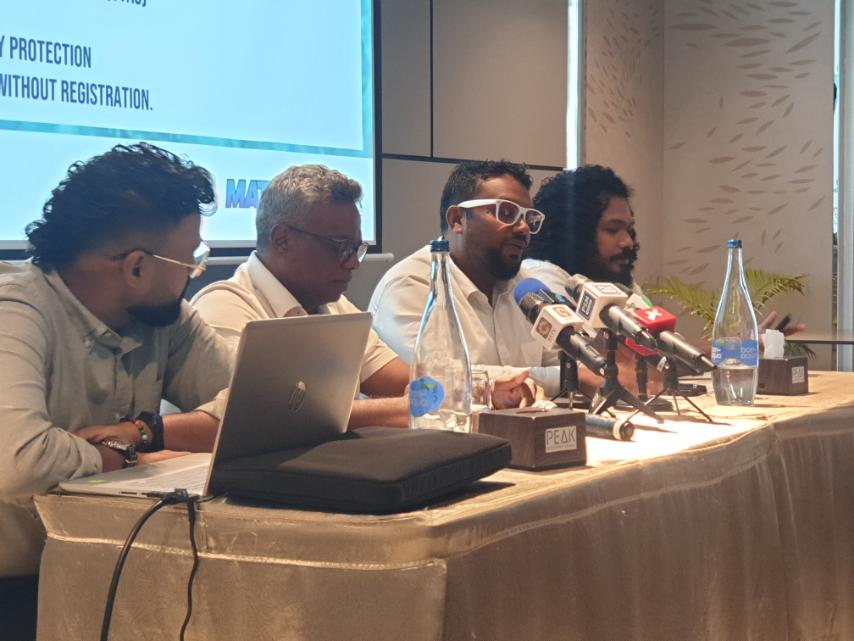
According to MATATO, the tourism industry in the Maldives faces significant challenges
October 18, 2023 | News | IMTM

Male’ Maldives, 18th October 2023 – The Maldives Association for Travel Agents and Tour Operators (MATATO) unveiled the outcomes of a recent survey, shedding light on the precarious state of the nation’s tourism industry. Abdulla Giyas, the President of MATATO, presented the findings of the survey during a press conference. It’s worth noting that the survey encompassed input from over 2,000 individuals, comprising not only local agents but also resorts, guesthouses, liveaboards, tourism experts, and small to medium businesses operating within the tourism sector.
The survey pinpointed several critical concerns and requests, as follows:
- The absence of regulations governing local travel agents.
- The necessity for a taxation system that protects local agents.
- Issues concerning unfair competition among online agencies.
- Challenges related to bank payments.
- The oversight of foreign travel agents and agencies.
Moreover, MATATO’s survey brought to light the fact that despite welcoming 1.4 million tourists this year, the occupancy rate in terms of bed capacity, which is set at 62,000, still falls short of the 50% mark.
The association also brought attention to the potential inadequacy of the Ministry of Tourism’s methods for gauging tourist arrivals.
During a press briefing, Mohamed Shaaz Waleed, Vice President of MATATO, stressed that the Maldivian tourism sector currently finds itself in a precarious position. He underscored that the recommendations stemming from the survey represent practical measures suggested by tourism professionals to tackle the situation, urging the incoming administration to seriously consider their implementation.
Reiterating Shaaz’s statements, Giyas emphasized the significance of voicing the concerns of the tourism sector in this period of transition. He noted that MATATO, in collaboration with stakeholders, members, and local agents, is actively advocating for the adoption of these recommendations.
Giyas also made a point of highlighting that the last comparable survey conducted in the Maldives dates back to 2011.
#iamwithIMTM #IMTM #imtmonline #maldives #maldivestourism #Maldivestourismindustry #maldivian #maldiviesnews #MATATO #research #resorts #sunnysideoflife #tourism #Travelnews
Last modified: October 19, 2023

Comments are closed.
News Updates
- The Cocoon Collection Unveils “Never Before Festival” to Redefine Maldives Holiday Experience
- Sheraton Maldives Full Moon Resort & Spa Introduces ‘Family Fun Summer’ Package
- Narain ‘Nick’ Sharma Joins SO/ Maldives as New Sales Manager
- Diamonds Thudufushi & Athuruga Illuminate Earth Day with Eco-Friendly Festivities
- Maalik Abdul Qayoom Joins THE OZEN COLLECTION as Sales Manager
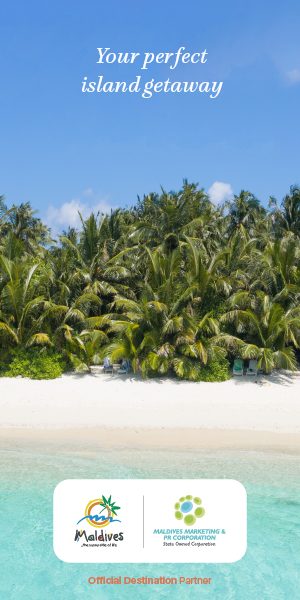
International Maldives Travel Market
H. Rankokaa First Floor | [email protected]
International Maldives Travel Market 2023

Fun Island Maldives
Pros And Cons Of Traveling To Maldives
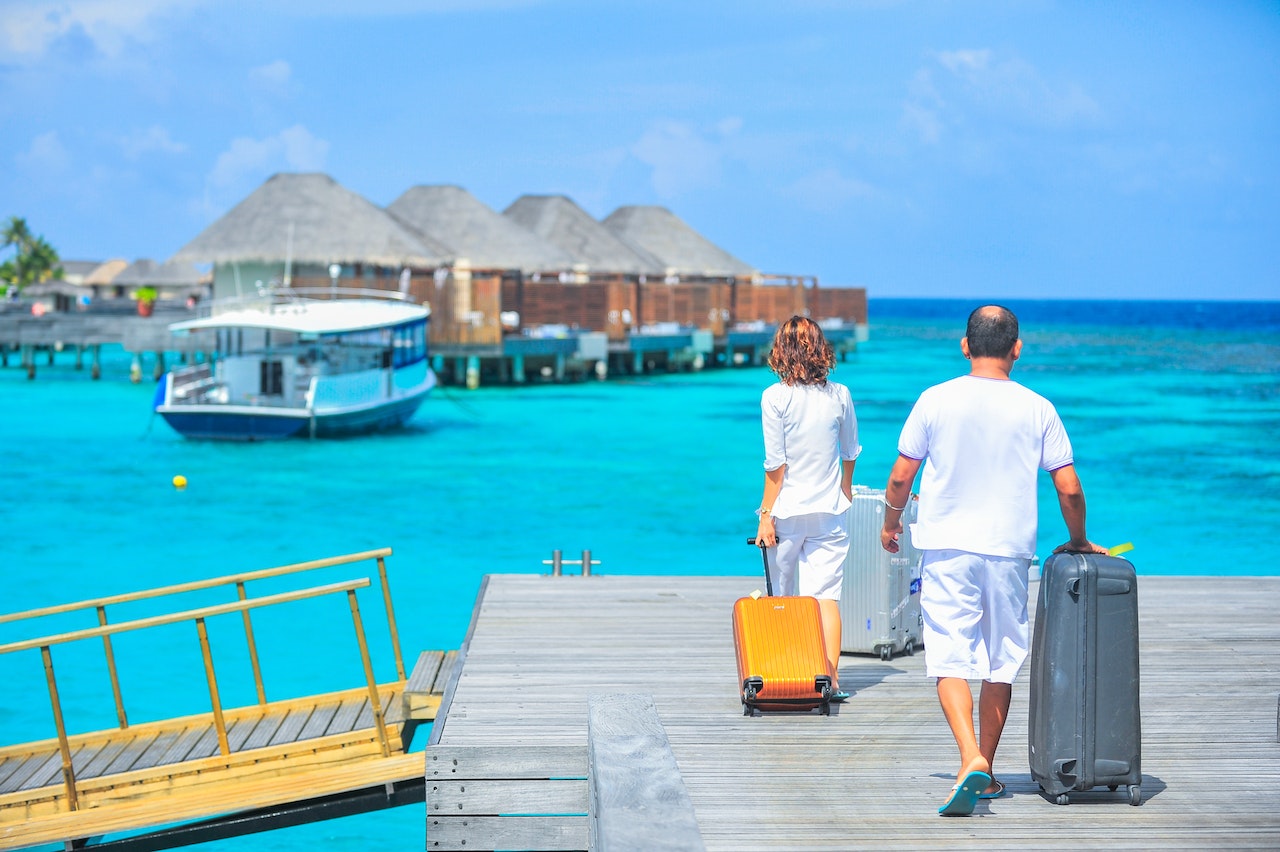
The Maldives is a tropical paradise that many people dream of visiting. With crystal clear water, white sand beaches, and lush vegetation, it’s easy to see why this country is so popular. However, before you book your tickets, it’s important to know the pros and cons of traveling to the Maldives. In this blog post, we will discuss some of the pros and cons of visiting this beautiful country.
The Maldives is a chain of islands located in the Indian Ocean. These islands are known for their beautiful beaches and pristine water, which is why they attract tourists from all over the world. While it is possible to stay at resorts on these islands, many visitors also choose to stay at guest houses owned and operated by locals, giving them an authentic experience of this tropical paradise.
Pros Of traveling To Maldives:
The Maldives is a tropical paradise, with crystal clear water and white sand beaches. It’s no surprise that so many people choose to visit this country every year. Some of the pros of traveling to the Maldives include:
1. The Beautiful Beaches And Crystal Clear Water: There’s no doubt that the beaches in the Maldives are some of the most beautiful in the world. Whether you’re spending your time swimming or just lounging on the beach, you’ll find that these islands have everything you could possibly want for a relaxing vacation.
2. The Variety Of Activities Available: Whether you’re looking for a relaxing vacation or an adventure-packed trip, the Maldives has plenty of activities to keep you entertained. You can go scuba diving to explore the coral reefs, take surfing and stand up paddle board lessons, or even try your hand at kitesurfing!
3. The Friendly Locals: The people of the Maldives are warm and welcoming, making it easy to feel at home in this tropical paradise. You’ll find that locals are always eager to help you out and share their knowledge of the islands with you.
4. The Delicious Food: The cuisine of the Maldives is a mix of Indian, Southeast Asian, and Middle Eastern flavors. You’ll find that there are plenty of restaurants serving up traditional dishes as well as innovative fusion options.
5. The Stunning Sunsets: Watching the sunset is a popular activity in the Maldives, and for good reason. The sky takes on a beautiful orange hue as the sun dips below the horizon, creating a magical backdrop for your evening activities.
6. The Wonderful Weather: The weather in the Maldives is warm and sunny year-round. You can visit at any time of the year without worrying about extreme temperatures, rain, or snow.
7. Good Wi-Fi Access: While some remote islands in the Maldives still don’t have internet access, most of the larger islands do offer reliable and fast Wi-Fi service. This means that you can stay connected with friends and family back home and plan your activities without having to worry about connectivity issues.
Cons Of Traveling To The Maldives:
While there are many great things about traveling to the Maldives, it’s important to keep in mind that there are also some downsides. Some of the cons of traveling to this island nation include:
1. The High Cost Of Travel And Accommodations: Unfortunately, the Maldives can be quite expensive compared to other tourist destinations. Not only is it more costly to fly out here, but you may also find that you need to pay quite a bit of money for accommodations and meals.
2. The Limited Availability Of Local Transportation: While it is possible to take public transportation in the Maldives, there aren’t always buses or other vehicles available at times that may be convenient for tourists. This can make getting around the islands more difficult than it needs to be.
3. The Lack Of Cultural Attractions: While the beaches and water are beautiful in the Maldives, there aren’t always many other things to do on these islands. If you’re looking for a more diverse travel experience, you may find that the Maldives doesn’t have quite as much to offer as some other destinations.
Overall, the pros and cons of traveling to the Maldives are fairly even in terms of number. Whether you’re looking for a relaxing tropical vacation or an adventure-filled trip, this island nation is sure to have something for everyone. If you’re planning your next vacation, consider visiting the Maldives for an unforgettable experience!
In conclusion, there are both pros and cons to traveling to the Maldives. Some of the main pros include its beautiful beaches and crystal clear water, as well as the variety of activities that are available on these islands. On the other hand, some potential cons of visiting the Maldives include its high cost and limited availability of local transportation. Ultimately, whether the Maldives is the right destination for you will depend on your personal preferences and travel needs. However, if you are looking for a tropical paradise with beautiful beaches and plenty of activities to enjoy, you may find that the Maldives is just what you’re looking for. So why not plan your next vacation here today?
View this post on Instagram A post shared by ~ J O H N & S O N I A ~ (@summerlove_stories)
View this post on Instagram A post shared by Maldives Insider (@maldivesinsider)
Who Is Fun Island Maldives?
Fun Island Maldives focuses on traveling the world and experiencing everything there is to know about The Maldives, a picture-perfect archipelago situated in the middle of the Indian Ocean and home to 1,190+ tiny coral islands! This amazing country is famous for the beauty it possesses and is celebrated as one of the best travel destinations in the world. For first-timers, traveling to the country will be very exciting but at the same time, there is so much more to look forward to and understand beyond the exotic lifestyles.
This article was written with the help of All Business Class, a top travel agency in San Francisco . All Business Class offers clients wholesale pricing that you can’t get anywhere else! You save money by booking with them because we earn a commission on their behalf. Plus, they offer vacation planning services so if there are any questions about your trip or accommodations, just let them know and they will be happy to help out! Get in touch today for more information about how their company can take care of all your travel needs – no matter what type of destination you’re looking for.
Leave a comment Cancel reply
Your email address will not be published. Required fields are marked *
Save my name, email, and website in this browser for the next time I comment.
- Investigative Stories
- Entertainment
- Life & Living
- Tech & Startup
- Rising Star
- Star Literature
- Daily Star Books
- Roundtables
- Star Holiday
- weekend read
- Environment
- Supplements
- Brand Stories
- Law & Our Rights

Most Viewed
Mutual Trust Bank to buy land for Tk 108 crore to build corporate headquarters
Secondary schools, colleges to open from Sunday amid heatwave
Islami Bank Bangladesh’s full-year profit rises to Tk 635 crore, highest since 2019
IMF calls for smaller budget amid low revenue receipts
Problems of tourism in Maldives
High-end tourism in the Maldives, the largest foreign exchange earner, is now in a vulnerable state. The stunning bungalows beside unpolluted beaches, sparkling aquamarine water, multi-coloured tropical fish in the reefs, water sports and glorious sunsets make Maldives one of the most beguiling tourist destinations in the world. This is now under threat. Thousands of protesters and members of the opposition Adhaalath party gathered on December 23, 2011, to "Defend Islam." The five demands to the government were (i) to stop flights to Maldives from Israel, (ii) to close spas and massage parlours in tourist resorts, (iii) ban the sale of alcohol in sections of inhabited islands classified as uninhabited, like the venue of the last Saarc Summit in Addu City and Favenmulah, (iv) condemn the Chief of UN Human Rights Navi Pillay for her comments against flogging, and (v) remove allegedly "idolatrous" Saarc monuments in Addu city. The Parliament's National Security Committee passed a resolution advising against licensing of Israel's airline to operate direct flights to Maldives. The government pointed out that the monuments built for Saarc in Addu fell under the jurisdiction of the Addu City Council and only Parliament could issue a statement against Ms. Pillay as she had directed her comments to the Majlis. Her visit was organised by the UN office. Although Maldives is a 100% Islamic state, historically it was a trading junction for several ancient maritime civilisations including Egyptians, Romans, Arabs and Indus Valley traders. It was a Buddhist state that converted to Islam around 1153 AD. But, it remained an open state with the prevailing customs of the country as its distinctive features. Home to some 330,000 Muslims, Maldives has a reputation of a paradise holiday destination, but this image has come under question due to minority religious fundamentalists. By 1993, the country developed economically through the now massive tourist industry and stable trade in fishing. Tourism is strictly regulated and, except for Addu atoll, resorts have been established only on uninhabited islands. The World Tourism Organization cited Maldives as a model for sustainable tourism development. But, after the recent protests, the tourism ministry instructed resort hotels on the nation's pristine coral islands to close all spas and health centres. Immediately, over 100 spas were shut down. The opposition Adaalath party and Islamists claimed that resorts were fronts for prostitution. This is totally untrue and has been refuted by the Maldives Association of Tourism Industry (MATI). Tourism in the Maldives is a popular destination for wealthy honeymooners where bungalows can cost up to $12,000 per day. This industry is essential for the national economy. Maldives specialises in winter sun for Europeans making its high season from December to April when the country enjoys dry weather. But numerous reservations have been cancelled after the December 2011 protests, causing "irrevocable damage." The government has lifted the controversial nationwide ban on spas with immediate effect. The announcement was made by President Nasheed during a press conference on January 4 at Kurumba Island Resort, the country's first resort opened in 1972. Nasheed rejected religious extremism and urged the people to support a "tolerant" form of Islam practiced in the country for centuries. He added that he was confident that the institutions of state would recognise the importance of upholding national development and not damage this lucrative industry. Information revealed that as soon as the ban was imposed on spas, the opposition parties, headed or influenced by resort owners, swiftly changed their stance and stated that they did not want to damage the industry. The week-long ban made headlines in both national and international media and reported in BBC. "The government does not want the economy to suffer any damage during the time the Supreme Court takes to come to a decision," stated President Nasheed. The government's action woke the nation from its slumber and sparked a healthy debate about the future direction of the country. Maldives is a middle income country with GDP per capita (2010 est.) of $4,770 and inflation is 4.7%. In recent years. The country greatly benefitted from tourism, which brings around $600 million annually. Tourism and related services contributed to over 29% of the GDP in 2010. But, its indirect contribution is much higher. As a result, this industry is a catalyst for growth. More than 95 islands are operating as resorts and over 790,000 tourist visited Maldives in 2010. The country experiences capacity utilisation rate of over 80% to 95% in peak winter tourist seasons. A country of many contradictions, tourism flourished for 40 years selling alcohol, pork and promoting spas. It was possible to do this, although contrary to the principles of Islam, by designating resorts as "uninhabited islands" even though locals from the south of Maldives work there. Ironically, the recent protest is not for religious reasons, but is being used as a tool. Seriously divided along political lines, Islamic nationalism remains a strong political card for the opposition parties that could well influence the outcome of the 2013 presidential election. By allowing this political issue to be addressed early and by reiterating the history of tolerant Islam in the Maldives, Nasheed has challenged the rival camps. With a backdrop of deteriorating fiscal control due to increased government spending and faltering revenue, the budget deficit was about 16% of the GDP in 2010. Government expenditure was 51% of GDP with revenue of about 34%. This has led to a sharp build up of public debt prompting the World Bank and the IMF to classify Maldives as being at moderate risk of debt distress. In such a scenario, any significant decrease of revenue from tourism will place the country into further deficits with poor growth and increased vulnerability. It is unfortunate that the greatest foreign exchange earner should be a subject of political contention and endangered by power dynamics.
The writer is a former High Commissioner of Bangladesh to Maldives and former Head of Human Resource Development Initiative, Commonwealth Secretariat, UK.
For all latest news, follow the daily star's google news channel..

‘পুষ্পপাগল’ কৃষ্ণচূড়ার আগুনঝরা দিন
খররোদের তপ্ত দিনে প্রায় দুই কোটি মানুষের ব্যতিব্যস্ত ঢাকা মহানগরে এখন কৃষ্ণচূড়ার রাজত্ব।
আজ সর্বোচ্চ তাপমাত্রা ৪২ দশমিক ৬ ডিগ্রি, গরম কমবে কবে জানাল আবহাওয়া অধিদপ্তর

The Maldives is racing to create new land. Why are so many people concerned?
By Jesse Chase-Lubitz
Photography by Neeta Satam for Nature
24 April 2024

The island nation is expanding its territory by dredging up sediment from the ocean floor.
But scientists, former government officials and activists say such reclamation can harm marine ecosystems and make the country more vulnerable to rising seas..
This article was produced in partnership with the Pulitzer Center.
This article is also available as a pdf version.
“Sun, sand and sea.” Those are the three ingredients for tourism in the Maldives, Mohamed Shaiz’s father told him. For more than a decade, Shaiz’s family owned a successful local hotel in Addu, the Maldives’ southernmost atoll. But nearly 9 months ago, the government took away the sea.
A state-sponsored project had pulled up sediment from offshore areas and used it to extend the beach in front of the hotel by 130 metres — too far to walk for most tourists who want easy access to the ocean. Now all Shaiz sees from his hotel is a human-made desert and a slew of cancelled reservations.

The view in front of Mohamed Shaiz’s hotel on Addu Atoll.
The Maldives is an 820-kilometre-long chain of nearly 1,200 islands dotting the Indian Ocean. The nation has become one of the most popular luxury tourism destinations in the world because of its Instagrammable beaches and its advertising slogan: “the sunny side of life”. But the Maldives is also one of the countries most vulnerable to sea-level rise . With 80% of its land less than one metre above sea level, some scientists predict that the islands could be completely submerged by 2100.
In an effort to keep the country above water and thriving, the government is adopting a strategy used by many nations around the globe : land reclamation. The sandy stretch in front of Shaiz’s hotel is some of the newest land on the planet, dug up from the bottom of the ocean, sucked through pipes and piled along the coast to make more space.
Maldivian government officials say that the land is necessary to make room for economic development, especially as sea levels rise.
“This will be a doorstep, a job destination and an income-generating destination,” said President Mohamed Muizzu at the inauguration of a new land-reclamation project last December.
Critics are unconvinced, and say that the country has enough space to thrive. One swathe of land on a neighbouring island near Shaiz’s hotel was reclaimed in 2016. It remains undeveloped today. “Call me in five years,” Shaiz says, gesturing to the newly created desert in front of his hotel. “This land will be the same.”

Mohamed Shaiz and his family own a hotel on Addu Atoll.
In addition to the disputed economics, there is serious concern about the environmental damage that land reclamation can cause. Studies in the Maldives and at other sites around the world have shown that it can harm corals and seagrass, damage natural barriers, such as sand bars, mangroves and estuaries, and destroy marine habitats. “Atolls are extremely vulnerable ecosystems,” says Bregje van Wesenbeeck, the scientific director of Deltares, a Dutch research institute for water management in Delft. “Once you start to interfere with them, you’re sort of failing them.”
Expanding territories

The island of Gulhifalhu lies just west of the capital, Malé. A reclamation project started in 2020 is filling in half the atoll.
Dutch planners are often considered the founders of land reclamation, with a history of water engineering going back some 800 years. Over the centuries, land-forming projects have shaped some of the world’s major cities, including Singapore, London, New York and Miami. In recent decades, most of the reclaimed land has been in East Asia. In China, Shanghai has reclaimed 350 square kilometres — more than three times the size of Paris — over the past few decades. Colombo has added 100 km 2 in just 4 years, and 65 km 2 of Mumbai is reclaimed. A study on twenty-first-century coastal-land reclamation found that of 135 large coastal cities with populations of more than one million people, 75% had reclaimed land 1 .
With projects stretching back to 1997, the Maldives is a veteran of large-scale land reclamation. Then-minister of state for environment Abdulla Naseer said in 2018 that there are an estimated 50 islands with reclaimed land in the country, although many specialists say that’s a conservative estimate.

Source: Maldives Land and Survey Authority
Land scarcity is a key factor driving reclamation projects. Although the nation’s territory covers 90,000 km 2 , more than 99% of it is ocean. Around half a million people live on a total land area of just 300 km 2 , and the country welcomes around 1.3 million tourists each year, who contribute 80% of its gross domestic product. The capital, Malé, is one of the most densely populated parts of the planet. It’s possible to walk across the entire island in 20 minutes.

Images captured by LANDSAT satellites in 1997 and 2020 show the impact of reclamation projects on Malé and nearby islands.
Credit: Lauren Dauphin/NASA Earth Observatory
The Maldives’ 1,200 islands are all atolls — rings of coral reef that surround lagoons. When the government decides to reclaim land, it takes sand from the lagoons using boats outfitted with suction pipes, which collect sand and coral debris from the ocean floor like giant vacuum cleaners. The boat then deposits the material in a different spot, either inside or outside the atoll, to form new land. Sometimes reclamation projects fill in the entire lagoon.
Environmental damage

Heaps of sand and debris are piled up next to Shaiz’s hotel and behind the new patch of reclaimed land.
Addu Atoll, the site of Shaiz’s hotel, is about two hours south of Malé by aeroplane. Its rich coral reefs support more than 1,200 species of fish — one of the factors that led the United Nations cultural organization UNESCO to include the atoll in its World Network of Biosphere Reserves in 2020.
Some of the islands are so narrow that you can almost always see water on both sides while standing in the centre. It’s a largely quiet and rural place that feels forgotten. Yet construction marches on.
The Ministry of National Planning, Housing and Infrastructure announced the Addu Development Project in 2021, aiming to reclaim parts of the atoll and develop a road connection between existing islands. One of the ministry’s justifications is that it will provide extra housing. In the Maldives, land for houses is given away to eligible individuals and families. Addu City’s mayor, Ali Nizar, says that there have been more than 5,000 requests for housing since he entered office in 2021. “We need land,” he says. “There’s no other way.”

A reclamation project in Addu started in early 2023 and is adding land for housing, businesses and resorts.
Because Addu has one of the few international airports in the country, the hope is also that the extra land will attract international investment. “With this huge expansion project, the transformational development of Addu City has commenced,” said former president Ibrahim Mohamed Solih after inaugurating the project in June 2023.
The project has been controversial from the start. When it was announced, Ibrahim Mohamed was sitting at his desk at the Maldives’ Environmental Protection Agency (EPA) in Malé. He instantly had concerns about how the project would affect Addu. Mohamed grew up in Addu in the 1970s, taking walks through the massive seagrass beds near his home. He remembers watching stingrays surf the waves, and marvelling at fiddler crabs along the shore.
Mohamed led the environmental impact assessment (EIA) process for land-reclamation projects. When the Addu proposal landed on his desk, he contracted an environmental consulting group called Water Solutions, headquarted in Malé, to do the review.

The environmental impact report , published in February 2022, found that “the proposed reclamation is well received by the community” and that there was “high interest to implement the project based on the potential economic benefits”. But it also concluded that “long-term irreversible negative impacts will be generated from the project” for both the environment and the community, including by destroying coral reefs and seagrass meadows and harming the fishing and tourism industries.
“It was sufficient enough for the EPA to reject the project,” Mohamed says. “But they didn’t.” In May 2022, he quit his job after 10 years at the agency.
After the report came out, the EPA pushed for changes, such as a smaller area from which the project would source sand. “We tried to change the scope because we are here to protect the environment and at the same time, help development,” says the agency’s director-general, Ibrahim Naeem. “Development has to go hand in hand with environment. It should not destroy the environment,” he says.
Once the changes were made to the proposed project, Water Solutions produced a second report to assess the environmental impacts at the end of September 2022. It found that the altered project, with increased mitigation and monitoring in place, would still have irreversible negative impacts — ranging from moderate to major — on marine plants and animals, protected and sensitive areas, tourism, fisheries and recreational activities.
The assessment calculated that the cost of the damage to coral reefs alone would be between US$340 million and $851 million.
The September 2022 report does not offer explicit recommendations. “Our role is to share the information. We just wanted to present the facts,” says Ahmed Jameel, managing director of Water Solutions and one of the authors of the report. However, he adds, the assessment was not vague in its conclusions. The findings showed clearly that the project “would have an overall negative impact”, he says.
When asked about the concerns raised in the second report, Naeem says that the findings, combined with insights he received from EPA staff members who conducted anonymous reviews of the EIA, indicated that there was “enough justification in the report to approve it in terms of social benefit”.
“Any development projects in this type of environment, especially in the marine area, will have an impact,” he says, adding that “if you do reclamation properly, and if you do it wisely, I think impacts can be minimized”.

Ibrahim Mohamed previously worked for the Maldives’ Environmental Protection Agency.

The construction company Van Oord is performing the reclamation work for the Addu Atoll project.
The Dutch company responsible for doing the construction on the project, Van Oord, told Nature that environmental management for the project is overseen by the EPA and that it is working with the agency and local specialists to minimize the environmental impacts. Van Oord said it prepared a comprehensive environmental management plan “based on the mitigation measures mandated in the EIA and in compliance with international guidelines”. As part of its efforts, the company relocated coral and seagrass, and added silt screens to limit how much sediment would flow beyond the reclamation zone and affect other areas.
Van Oord, which is based in Rotterdam, the Netherlands, told Nature that “all the predicted impacts have been effectively managed by implementing a series of mitigation measures”.

A new house on Hulhumeedhoo island, to the northeast of Addu City, remains unfinished and unoccupied.
In October 2022, the EPA approved the project. But critics say the environmental costs of the reclamation are too high.
“I think their efforts are not worth the amount of destruction and the irreversible damage,” says Mohamed. “It can never be compensated properly.”
Today, the land in front of Shaiz’s hotel is the result of that decision. Yet if you speak to people on Addu, many say that land is not what they need right now; they need jobs. Much of Addu is filled with empty, unfinished homes because individuals don’t have the income or resources to build houses on their free land.
“Fifty per cent [of our land] is abandoned or empty,” says Addu’s former deputy mayor, Abdullah Thoyyib, who served the city before this reclamation project took place. “We need economic benefits and job opportunities, but that’s not happening.”
Reefs at risk

Reclamation projects in the Maldives can fill the water with sediment, threatening coral reefs.
Sitting in a resort in Addu City, Nisal Musthag places a map of Addu’s main diving spots on the table. Musthag leads diving trips for one of the two active resorts in the atoll, and he has seen some of the damage that follows reclamation projects. He points at one of the four channels between the island’s lagoon and the ocean. “This is like a cemetery now,” he says.
Musthag does three to four dives a day, six days a week. Since the most-recent reclamation, there are at least five sites he no longer takes guests to. “There are people who come back every year to dive, and this year they were like, hey, what’s happening?”

Nisal Musthag leads diving trips in Addu, but has stopped taking tourists to spots where coral was damaged by reclamation projects.
The impacts of reclamation on coral health are one of researchers’ main concerns. Some reefs die when sediment is dumped on them to create new land. But even corals that escape direct damage can be harmed because the construction work creates clouds of sediment that spread out and settle on more distant reefs. Robbed of light and nutrients, these corals can struggle to survive. The damage to reefs not only harms the ecosystem but can also leave the islands vulnerable to storms and sea-level rise, say scientists.
To reduce damage to corals during the work at Addu, the EIA required that at least 10% of existing corals be relocated outside the reclamation footprints. Van Oord says it has moved 73,000 corals to 9 recipient sites identified in conjunction with the EPA. The firm says that it “certainly surpassed the EIA requirement”.
Saleem Rashid is one of several local divers who helped to relocate the corals. He has been monitoring them for the past year. One species, blue coral ( Heliopora coerulea ), which was moved from the outside of the atoll to the inside, died completely. “We moved 80 colonies,” says Rasheed. “They survived one week and died entirely after six months.”
“We need land. There’s no other way.”
Ali Nizar, Addu City’s mayor, supports the island’s reclamation projects.

Fathimath Saaira, social-justice advocate in Addu.
“I worry that our livelihood is being stolen from us. Our nature is being snatched away.”
Fathimath Saaira is a social-justice advocate in Addu who opposes the reclamation there.
But the rest of the species have shown resilience. Three months after relocation, they were struggling, but now, Rasheed says, they are alive and well.
Researchers have found that coral relocation can work if colonies are moved to areas with similar conditions that are protected from waves. A 2017 study in Hawaii, for example, showed that relocated corals were thriving a decade after they were moved 2 . One study on coral restoration and relocation in the Maldives measured the survival rate of 242 coral fragments 12 months after they had been moved 3 . The authors found a 70% survival rate, which they concluded was a promising result.

A solitary mangrove tree grows near newly reclaimed land in northeast Addu.
A grey heron joins others on a new sea wall built in Addu.
But coral health is only one concern for researchers studying the effects of reclamation. Mangroves, seagrass beds and coastal ecosystems can also be in harm’s way, say scientists.
Water Solutions’ second report about the Addu project, for example, projected that the reclamation process would bury about 98 hectares of seagrass meadow in the atoll’s lagoon, at an estimated economic cost of more than $3.7 million a year.
Uncertain future

Coral debris makes up much of the reclaimed land.
Not far from Shaiz’s hotel, a sea wall stretches towards the horizon, protecting a new swathe of land made of sand and coral debris. Coastal protection efforts such as the sea wall — and the changes wrought by reclamation — could have long-lasting effects on the processes that keep the islands from eroding, say researchers.
Like other atolls, the Maldivian islands evolve with the seasons, with monsoons moving sand around them. Between December and February, the winds transport sand from the northeast to the southwest. Between June and August, the pattern reverses.
“In a natural island, you will see seasonally the sand shifting with the waves and the currents,” says Mohamed. But reclamation can impede this process, he adds, by taking sand and coral debris from some locations through dredging — leaving a deficit in its wake — and depositing it where natural flows wouldn’t. Some projects add another complication by building hard barriers, such as sea walls, to protect the land, because they can stop the natural flow of sediments.
“Ecosystems can adapt if we allow them to,” says van Wesenbeeck at Deltares. “By interfering, you will kill the whole system in the end.”
Not only does this change how the island naturally maintains itself, but it can also draw development to places that are at a high risk of a storm surge or erosion, say some researchers.
“Islands can’t occur anywhere,” says Virginie Duvat, a coastal geographer at La Rochelle University in France, who has studied the effects of land reclamation in the Maldives. “If you put an island where there was naturally no island, you create vulnerable land and you will necessarily have to build strong engineered structures, breakwaters and sea walls,” she says.

A reclamation projection near Malé.
Thilafushi is an industrial island near Malé that hosts one of the country’s large rubbish dumps. New land is extending the island westward.
In a 2019 study 4 , Duvat and Alexandre Magnan, a geographer at the Institute for Sustainable Development and International Relations — Sciences Po in Paris, assessed the scale of coastal changes that humans had made to 107 inhabited islands in the Maldives between 2004–06 and 2014–16. On almost half the islands, the researchers found significant degradation in the reefs’ abilities to weaken waves and provide natural sources of sediments. One-fifth of the islands had almost entirely or entirely “lost their natural capacity to respond and adjust to ocean climate-related pressures”, the researchers say.

Source: Ref. 4
“It means that a decision you have taken one day to rely on reclaimed land will necessarily cause you to invest more money,” says Duvat. “You are locked into the engineered path for decades and decades and potentially the rest of the century.”
“If you build a levee, people will think they’re safe,” says van Wesenbeeck. “But is it wise to destroy environmental assets to create investment in an area that’s one of the most vulnerable in the world for climate change?”
The city of hope

A new housing development in Hulhumalé.
Some 550 km to the north of Addu, the capital, Malé, sits like an overpopulated postage stamp in the middle of the ocean.
Malé is tiny — less than 2 km across at its widest point — but more than 200,000 people live on the island. To relieve population pressures, the government decided in the late 1990s to start reclaiming a massive atoll next to Malé, called Hulhumalé.
Hulhumalé has become known as ‘the city of hope’ — a place that not only has room but is also protected from sea-level rise. Architects designed it with sea-level-rise scenarios until 2100 in mind. The outer edges are 2 metres above sea level, more than twice the height of Malé.

LANDSAT photos of Hulhumalé (the long island on the right) show how much reclamation projects have altered it between 1997 (left) and 2020 (right). Malé is at the bottom of the photo. Credit: Lauren Dauphin/NASA Earth Observatory
Hulhulmalé is regarded by specialists mainly as a worthwhile success for land reclamation, but critics have raised many questions about three newer projects on the western side of Malé, all of which are being built using sand from the nearby lagoon.

Malé’s busy skyline, seen from the nearby island of Vilimalé.
In 2021, Humay Abdulghafoor, a Malé-based veteran fighter against land reclamation, sued three institutional bodies of the government on the grounds that they violated an environmental-protection law. She said that a new reclamation project risked causing serious environmental, economic and cultural damage to the local community by undermining “the economic and social benefits flowing from the natural environment and biodiversity richness of the Maldives”, according to her legal case.
“By destroying the Maldives, you cannot develop it,” she says.
The case has been ongoing for years, but on 14 February, it had its first breakthrough. The country’s High Court decided to pause a dredging project near Malé. However, the next day, the Supreme Court said that this pause would cause significant financial losses and overturned the decision.
“By destroying the Maldives, you cannot develop it.”
Humay Abdulghafoor, who has sued the government over its reclamation plans.

“How we create land, and the extent to which we do it, is excessive.”
Mohamed Aslam, former minister of planning, infrastructure and housing.
Mauroof Jameel, one of five architects chosen to build Hulhumalé, also has concerns about the latest projects. Jameel, who is based in Malé, says that it made sense to reclaim land at Hulhumalé to address congestion and help to build up the economy, but he is hesitant about how fast reclamation projects are now taking place. No one knows what the long-term impacts will be, he says.
In many parts of the world, including the Maldives, land reclamation can be beneficial, say scientists. “In my opinion, it can be a positive thing around Malé,” says Duvat, because of population pressures there. But she doesn’t see as much justification in more rural, distant atolls. “In this case, I cannot see the benefits.”
Should the Maldives be creating new land?
Officials with the Maldivian government acknowledge that land reclamation can cause harm. But there is no indication that the process is slowing down. Just 3 months after Muizzu was inaugurated as president last November, he announced the biggest reclamation project the nation has ever seen —another endeavour to reclaim land near Malé on top of those already in the works. “The brand-new model city will revolutionize the country’s urban landscape, addressing housing challenges in the greater Malé region by providing 65,000 housing units,” he said in February at the World Governments Summit in Dubai, United Arab Emirates.
But many former officials urge caution. “How we create land, and the extent to which we do it, is excessive,” says Mohamed Aslam, the minister of planning, housing and infrastructure for the previous administration, the agency responsible for land-reclamation projects. He says that land is ofen reclaimed as an easy way to keep the public happy, to show them that the government is doing something.
“The easy part is building the land,” he says. “Only after that does the hard part begin.”

- Author: Jesse Chase-Lubitz
- Original photography & drone footage: Neeta Satam for Nature
- Logistical support in the Maldives: Shah Ahmed Yusuf
- Media editor: Agnese Abrusci
- Subeditor: Francisca Schultz
- Editor: Richard Monastersky
- Sengupta, D. et al . Earths Future 11 , e2022EF002927 (2023).
- Rodgers, K. S. et al . PeerJ 5 , e3346 (2017).
- Pancrazi, I., Feairheller, K., Ahmed, H., di Napoli, C. & Montefalcone, M. Diversity 15 , 1022 (2023).
- Duvat, V. K. E. & Magnan, A. K. Sci. Rep . 9 , 15129 (2019).
- Privacy Policy
- Use of cookies
- Legal notice
- Terms & Conditions
- Accessibility statement

25 Important Disadvantages of Tourism
Disclaimer: Some posts on Tourism Teacher may contain affiliate links. If you appreciate this content, you can show your support by making a purchase through these links or by buying me a coffee . Thank you for your support!
I am sad to say that there are many disadvantages of tourism. Tourism has the power to do so much good, but equally it also has the power to do so much bad. The key is careful and sufficient tourism planning and management. So what are these disadvantages of tourism, why are they so bad and how can we overcome them? Read on to find out…
The 3 categories of disadvantages of tourism
Natural habitat disruption, resource depletion, climate change, wildlife disturbance, coral reefs damage, seasonal nature of tourism, economic dependence, revenue leakage, unequal distribution of income, opportunity cost, over-reliance on a single industry, environmental costs, cost of living, cultural commodification, cultural displacement, commodification of culture, overcrowding, increased crime, social inequality, change in local lifestyles, loss of local employment, inflation in property prices, sustainable tourism practices, involving local communities, education and awareness, diversification of the economy, government regulations and policies, infrastructure development, long-term planning, adaptable management strategies, the disadvantages of tourism- to conclude, the disadvantages of tourism.
As one delves into the captivating world of globetrotting, it is easy to become enamored with the captivating allure of exploration, adventure, and cross-cultural interactions that define the tourist experience. Tourism, undoubtedly, contributes significantly to the economic prosperity of nations, providing employment , generating foreign exchange, and fostering cross-cultural understanding . Yet, there exists a darker side to this glittering façade, one that, more often than not, escapes the radar of mainstream discourse.
This post will highlight the less celebrated aspects of tourism, focusing on its potential downsides that are, somewhat ironically, entwined with its many benefits. Despite the ubiquity of tourism and its significance in today’s globalised world , it is crucial to address its potential for harm in the name of balance and long-term sustainability .
The downsides of tourism are numerous, encompassing aspects such as the environment, culture, economy, and social fabric of tourist destinations . Through this article we will delve into these impacts, seeking to not merely criticise, but also to inspire a rethinking of our attitudes and practices around tourism. By doing so, we endeavour to shed light on how we might navigate these complex issues and foster a more responsible and sustainable approach to tourism .
The disadvantages of tourism can be broken down into three categories: economic, environmental and social. I have summarised these below for you.
Now lets dig a bit deeper into the disadvantages of tourism outlined above one by one…
Environmental Disadvantages of Tourism
If responsible tourism practises are not employed, tourism can, and does, cause significant harm to the environment. I have outlined some of the most common examples of the environmental disadvantages, also known as environmental impacts of tourism , of tourism below for you.

Tourism often leads to deforestation and disruption of natural habitats to accommodate tourists , causing a significant loss of biodiversity. This could involve clearing land for accommodations or other facilities, thereby endangering flora and fauna unique to the area.
How can we mitigate or reduce this disadvantage of tourism?
Sustainable tourism practices, including limiting development in sensitive areas, promoting eco-tourism , and educating tourists about responsible travel , can help preserve natural habitats.
Tourism can strain natural resources, particularly water and food supplies, especially in regions where these resources are already scarce. The increased demand can lead to overexploitation, endangering the long-term availability of these resources.
Implementing resource management strategies, promoting the use of renewable resources, and encouraging tourists to respect local resources can help mitigate this issue.
Tourism contributes to various forms of pollution. Air pollution results from transport, noise pollution from increased activity, litter from irresponsible disposal of waste, and other types of pollution, all of which can degrade local environments and disturb wildlife.
Establishing and enforcing environmental regulations, utilising environmental impact surveys , promoting green travel options, and educating tourists about proper waste disposal can help reduce pollution.
High tourist traffic can cause physical damage to natural landscapes. For example, excessive hiking and foot traffic can lead to soil erosion and degradation of historic sites, damaging these irreplaceable resources.
Restricting access to vulnerable areas, creating designated pathways, and educating tourists about the importance of preserving these sites can help reduce erosion.
The carbon footprint from travel, especially air travel, contributes to greenhouse gas emissions, leading to global climate change. Tourism’s contribution to climate change can have far-reaching consequences for ecosystems worldwide.
Promoting low-carbon transportation options , implementing carbon offset programs, and raising awareness about the environmental impacts of travel can help mitigate tourism’s contribution to climate change.
Human interaction can disturb the natural behaviour of wildlife. Some species may become overly dependent on human food sources, while others may react aggressively or retreat from their natural habitat, disrupting the balance of local ecosystems.
Educating tourists about respectful wildlife interaction, enforcing rules about feeding wildlife, and promoting non-intrusive wildlife viewing experiences can help to reduce disturbance.
Activities like snorkelling and diving can unintentionally damage delicate coral reefs . Additionally, increased boat traffic can lead to oil leaks and other pollution, posing a threat to marine life.
Implementing and enforcing marine protected areas, educating tourists about coral-friendly snorkelling and diving practices, and monitoring boat activity can help protect coral reefs.
Economic Disadvantages of Tourism
Unfortunately, there are many economic disadvantages of tourism, also known as negative economic impacts of tourism . I have outlined the most common below.

Tourism tends to be seasonal, often peaking during particular times of the year. This fluctuation can lead to periods of high employment followed by periods of widespread job loss, creating economic instability. This cyclical pattern can be challenging for local communities that heavily depend on tourism, making budgeting and financial stability a strenuous task.
Diversifying tourism offers, promoting off-peak travel and developing other forms of sustainable local industries can help smooth out the seasonal fluctuations of tourism and provide more stable employment.
The increased demand for goods and services during the tourist season often leads to price inflation . This surge in prices can result in an increased cost of living for local residents, making everyday goods and services more expensive and less accessible.
Implementation of policy measures to control inflation and monitoring of prices, especially of essential goods, during the peak season can help ensure that locals are not negatively impacted.
Regions that rely heavily on tourism can become economically vulnerable in the face of downturns in the industry. These downturns can be triggered by numerous factors such as natural disasters, political instability, global pandemics, or even changing travel trends. This economic fragility poses a significant threat to the livelihoods of local communities.
Diversifying the local economy by promoting and developing other industries can help reduce dependence on tourism and build economic resilience.
Often, a substantial proportion of the revenue generated by tourism does not benefit the local economy but ends up in the hands of foreign-owned businesses , such as international hotel chains and airlines. This phenomenon, known as revenue leakage, can undermine the local economic benefits of tourism.
Encouraging and investing in locally owned businesses and promoting local goods and services can help ensure that more of the tourism revenue stays within the local economy.
The economic benefits of tourism are often unevenly distributed within a community, exacerbating income disparities. More affluent regions or populations tend to gain more from tourism, while less affluent regions or marginalised populations gain less, exacerbating economic inequality.
Implementing policies and practices that promote equitable distribution of tourism revenue can help counter this problem. This might include investing in community-based tourism projects and ensuring fair wages for all tourism-related workers.
Investment in tourism-related infrastructure and services can lead to the neglect of other sectors of the local economy, potentially limiting overall economic development. The resources devoted to tourism could be used elsewhere, potentially offering better long-term economic outcomes.
Balanced investment in various sectors of the economy can help ensure broader economic development, reducing the opportunity costs associated with over-investment in tourism.
Over-dependence on tourism can lead to the neglect of other potential industries, limiting the diversification of the local economy. This lack of diversification can leave the local economy vulnerable to shocks in the tourism industry.
Diversifying the local economy by promoting various industries can help ensure economic stability even when tourism experiences downturns.
Tourism often drives environmental degradation and loss of natural resources, which have their own economic costs. These can include the expense of building infrastructure in sensitive areas, cleaning up pollution , and the lost opportunities for alternative uses of the land .
Implementing sustainable tourism practices that prioritise environmental conservation can help to reduce these costs. This includes regulating tourist activities in sensitive areas and investing in sustainable infrastructure.
Increased tourism can raise property prices and the cost of living, making it challenging for local residents to afford their community. As demand for properties increases with tourist influx, locals may be priced out of their own housing market.
Governments can implement regulations and controls on property prices, especially in regions that are experiencing or are at risk of high tourism-driven property inflation. Policies can also be put in place to ensure affordable housing for local residents is protected and preserved.
The commercialisation of local culture and traditions for the tourist market can lead to “ staged authenticity ,” where cultural activities are modified to cater to tourists. This commodification can potentially lead to the loss of cultural heritage and its inherent economic value, damaging the uniqueness that made the location attractive in the first place.
Policies that protect and promote the preservation of cultural heritage can help counter this effect. Additionally, educating tourists about the importance of preserving local culture and promoting authentic cultural exchanges can lead to more respectful and sustainable tourism practices.
Social Disadvantages of Tourism
There are also many social disadvantages of tourism, also known as social impacts of tourism , that need to be considered. I have outlined the major issues that are commonly encountered below.

The influx of tourists can lead to displacement of local populations and their cultural identities, resulting in a loss of cultural diversity . This phenomenon often results from the pressure to accommodate tourists and can erode the local way of life.
Respecting and protecting local cultures, promoting responsible tourism , and involving local communities in tourism planning can help mitigate cultural displacement.
The commercialisation of local customs and traditions for the tourist market can lead to the loss of cultural authenticity and exploitation of cultural heritage. Traditional practices may be transformed into spectacles for tourists, sometimes leading to staged and insincere representations.
Promoting cultural understanding and respect among tourists, supporting community-owned tourism initiatives, and setting guidelines for respectful cultural engagement can help preserve cultural authenticity .
An influx of tourists can lead to overcrowding, straining local facilities and infrastructure, and reducing the quality of life for local residents. This can create tension between tourists and local communities and degrade the visitor experience.
Implementing visitor management strategies, promoting off-peak travel, and developing infrastructure in a sustainable way can help manage overcrowding.
Some destinations may experience an increase in crime rates associated with tourism, including theft, drug trafficking, and exploitation. This can disrupt the local social fabric and lead to unsafe conditions for both tourists and locals.
Enforcing laws, ensuring adequate security measures, and educating tourists about safe practices can help curb crime associated with tourism.
Tourism can exacerbate social inequalities if the financial benefits of tourism are not evenly distributed within the community. This can lead to social tension and resentment within the local population .
Ensuring fair wages, promoting local ownership of tourism businesses, and implementing policies that promote the equitable distribution of tourism revenue can help address social inequality.
The presence of tourists can influence the behaviour and attitudes of local people, sometimes encouraging undesirable behaviours such as begging or petty crime. This can disrupt local norms and create social issues.
Promoting responsible tourism, involving local communities in decision-making processes, and ensuring that tourism benefits flow to the community can help reduce negative influences on local lifestyles.
In some cases, tourism can lead to the displacement of traditional industries, causing job loss among local populations. This can destabilise local economies and disrupt social structures.
Encouraging sustainable and inclusive tourism development that complements rather than replaces local industries can help preserve local employment.
An influx of tourists can increase demand for real estate, inflating property prices and potentially making it unaffordable for locals to own property in their own community. Companies such as Airbnb can exasperate this issue. This can lead to social displacement and exacerbate economic inequality.
Implementing policy measures to control property price inflation and ensuring affordable housing for locals can mitigate this impact.
How Can Destinations Balance The Disadvantages of Tourism With The Advantages of Tourism?
Balancing the disadvantages of tourism and advantages of tourism is a delicate task requiring thorough planning, strategic management, and conscious efforts from all stakeholders involved, including tourists, the local community, and the government. Below are some strategies that can help:

This approach focuses on minimising the disadvantages of tourism while maximising the advantages of tourism. These practices might include limiting the number of tourists allowed in a certain area at any one time, promoting off-peak travel, and supporting eco-tourism initiatives.
By involving local communities in the planning and decision-making processes, destinations can ensure tourism development aligns with local needs and values. This can also help distribute the economic benefits of tourism more evenly, reducing social inequality.
Raising awareness among tourists about the impacts of their behaviour can lead to more respectful and environmentally friendly behaviours. This can be achieved through informational campaigns, signage, and guidelines, all of which can help to reduce some of the disadvantages of tourism.
By promoting other sectors of the economy alongside tourism, destinations can mitigate the risk of over-dependence on tourism and provide alternative employment options for local communities.
Governments can establish regulations and policies to manage the disadvantages of tourism. This might include zoning laws to protect sensitive environments, regulations to prevent exploitation of cultural heritage, and policies to ensure equitable distribution of tourism revenue.
Thoughtful and sustainable infrastructure development can manage the influx of tourists, mitigate environmental impacts, and enhance the quality of life for local residents.
Taking a long-term perspective in tourism development can help balance immediate economic benefits with the need to preserve a destination’s cultural and natural resources for future generations.
Given the unpredictability of tourism demand , adaptable management strategies can help destinations respond to changes and mitigate negative impacts. This might involve regular monitoring of tourism impacts, feedback mechanisms, and flexibility in policy implementation.
By adopting these strategies, destinations can work towards a more balanced and sustainable tourism model that reaps the benefits of tourism while managing the disadvantages of tourism.
As you can see, there are unfortunately many disadvantages of tourism. However, just because these disadvantages of tourism currently exist, doesn’t mean that have to continue. With adequate planning, policies and governance and with sustainability principles and long-term planning at the forefront of our minds, we can limit the disadvantages of tourism significantly.
If you enjoyed this article about the disadvantages of tourism, I am sure you will enjoy these too:
- Leiper’s Tourism System: A simple explanation
- What is industrial tourism and why is it so popular?
- What is e-tourism and how is it changing travel?
- 150 fascinating types of tourism you didn’t know existed
- 50 fascinating facts about the travel and tourism industry
Liked this article? Click to share!

Sustainable Tourism in Maldives
Sustainability and Climate Change are now a key focus in the travel and tourism industry becoming an intrinsic part of the post pandemic tourism rebound. More than 300 tourism stakeholders recently signed up to the Glasgow Declaration on Climate which recognizes the urgent need for a globally consistent plan for climate action in tourism.
Sustainable tourism is a concept that covers the complete tourism experience and is defined by the UN Environment Program and UN World Tourism Organization as “tourism that takes full account of its current and future economic, social and environmental impacts, addressing the needs of visitors, the industry, the environment and host communities.”
When responsibly planned and managed, tourism can support job creation, promote inclusive social integration, protect natural and cultural heritage, conserve biodiversity, generate sustainable livelihoods and improve human wellbeing. However, tourism is also vulnerable to climate change while at the same time contributing to it. A suitable balance must be established between the three dimensions of economic, environmental and social aspects to guarantee its long-term sustainability.
The aim of sustainable tourism is to increase the benefits and to reduce the negative impacts caused by tourism for destinations. This can be achieved by:
- Protecting natural environments, wildlife and natural resources when developing and managing tourism activities
- Providing authentic tourist experiences that celebrate and conserve heritage and culture
- Creating socio-economic benefits for communities through employment and income earning opportunities
The demand for sustainable tourism is notable. Research by Booking.com showed that 69 per cent of global travellers anticipate that the travel industry will offer more sustainable travel options. ABTA’s 2020 Holiday Habits research shows that half of the customers now consider sustainability when choosing a holiday, with 70 per cent stating plastic and plastic pollution was a defining factor. That’s three times as many as ten years ago, showing a definite trend in the eco-conscious mindset of holiday makers. The Maldives, as one of the worlds luxury destinations, has reacted to this market change, and is becoming a leader in sustainable and eco-friendly tourism, introducing innovative ways to mitigate their impact on the environment which sustains them.
Tourism is the largest industry in the Maldives, drawing visitors from all over the world, attracted by the promise of white sand, clear blue waters and abundant marine life. As the world’s lowest-lying country, these collections of sand will also be the first to be affected by global warming and the resulting effect on the oceans such as rising sea levels and coral bleaching.
The industry plays a major role in sustainability and climate change, from the carbon emissions of the transport methods transporting people around the atolls, to the luxurious furnishings, fittings, equipment, and provisions required to sustain them, plus the effect of the activities and numerous ancillary services. A vast amount of these services and items are derived from plastic which contribute to an ever-growing waste mountain, as once these luxury goods arrive in the Maldives there are limited resources to effectively dispose of them! Research shows that tourists, as well as the services provided to them, are the single highest generator of waste per capita.
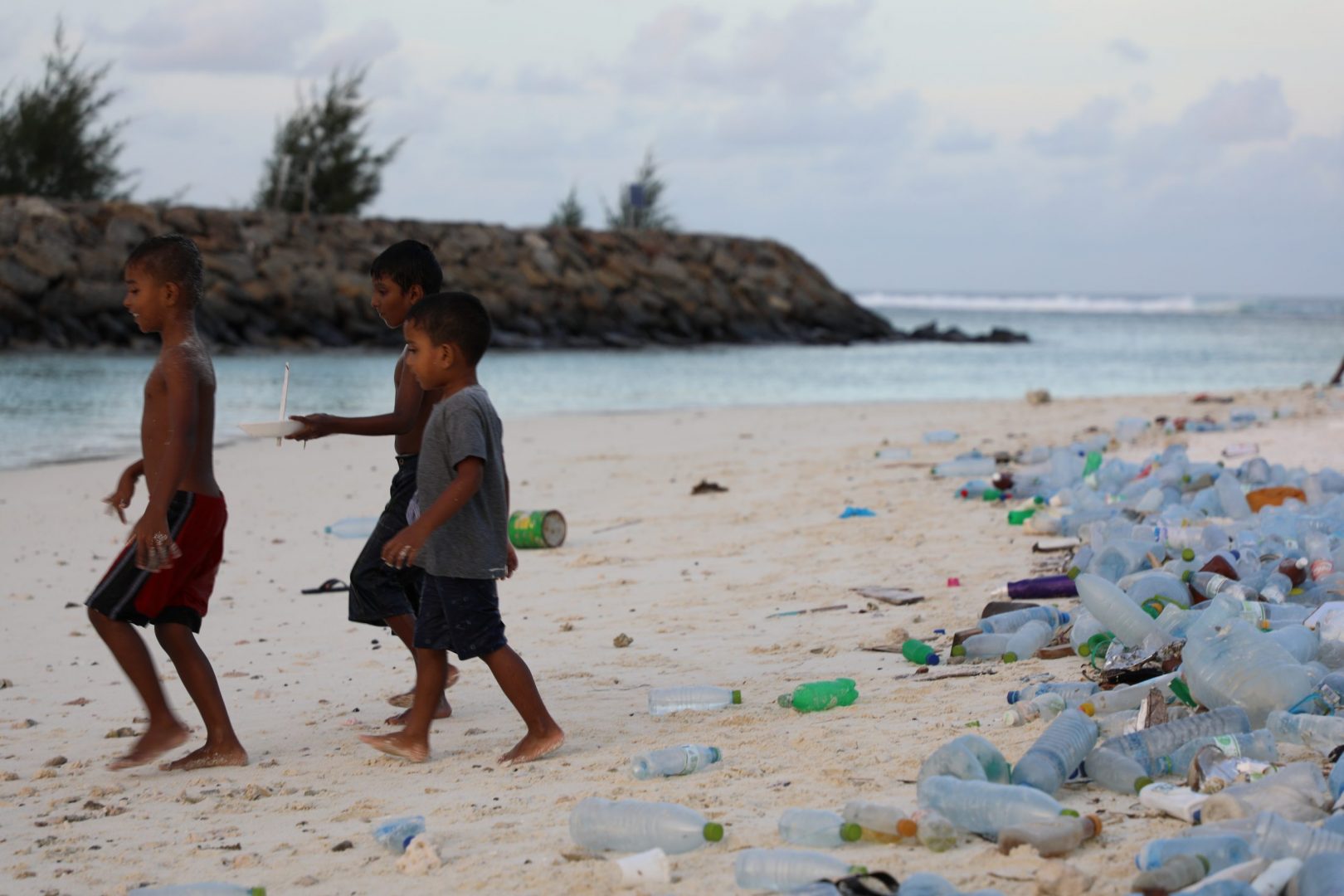
The MOPA (Maldives Ocean Plastics Alliance), NIG report details that plastics make up 12 percent of all waste produced in the Maldives annually, roughly 43,134 tonnes and estimates that solid waste is generated at a rate of 1.8 kg per person per day in Malé, 0.8 kg per person per day on the other inhabited islands, and 3.5 kg per person per day in resort islands. The rise in guesthouses and tourists on local islands has increased volume of rubbish generated and has emphasised the limited infrastructure for the management of wastewater and solid waste that the Maldives has.
The World Bank is working in partnership with the government to help with reducing the amount of waste, particularly plastic waste, as well as composting the high-volume household waste generated throughout the country through a variety of projects.
The “Greater Male’ Environmental Improvement and Waste Management Project” by the Environment Ministry is funded by the Asian Development Bank (ADB). The aim is to establish a sustainable solid waste management system for the Greater Male’ capital region and its inhabited outer islands. The project will establish a Regional Waste Management Facility (RWMF) with a waste-to energy treatment plant in Thilafushi.
The Maldives government actively encourage all the tourism sectors towards sustainability resulting in tourism providers partnering with notable organizations such as:
- Green Fins, a global initiative to reduce the environmental impact of marine tourism.
- Manta Trust, a UK based, independent non-profit organisation whose mission is to advance the conservation of manta rays and their habitats,
- Olive Ridley Project, which protects sea turtles in the Indian Ocean through research, education, and rehabilitation.
- Parley, an international NGO which, works to boost recycling and reduce plastic waste throughout the islands of the Maldives
The Government, local communities, and the tourism industry as a whole, are taking conscious steps to create more sustainable and eco-friendly products implementing a plethora of initiatives and activities to limit the damage to the environment and address the ecological impact of the tourists. These include:
- Parley collection points for PET plastic bottles which are then sent for recycling
- Bottling of water in reusable glass bottles
- Using natural insecticides to mitigate the use of toxic chemicals
- Solar panels and solar energy
- Trained marine biologists and conservation teams who conduct coral reef research, coral propagation, reef rehabilitation and look after coral nurseries.
- Education programs to provide guests with the opportunity to learn about conserving the oceans, sustainable living and the local fauna and flora
- Community initiatives to support their local islands by funding projects or supporting NGO’s and their programs
- Documented green practices and sustainable initiatives that are recognised by Earth Check, Green Globe and Conde Nest.
- Sustainability Labs that recycle plastic waste from the resort and surrounding communities into souvenirs and bricks, others turn recycled ocean plastic into models using 3D printers
- Gardens, farm areas, hydroponic areas, and orchards where produce is grown and supplied to the kitchens
Community education-programmes have also been created by resorts and non-governmental organisations to educate locals on sustainability. These programmes include a range of activities, including conducting regular beach and reef clean-ups on local islands, developing renewable energy sources, educating locals on practicing responsible fishing, and much more.
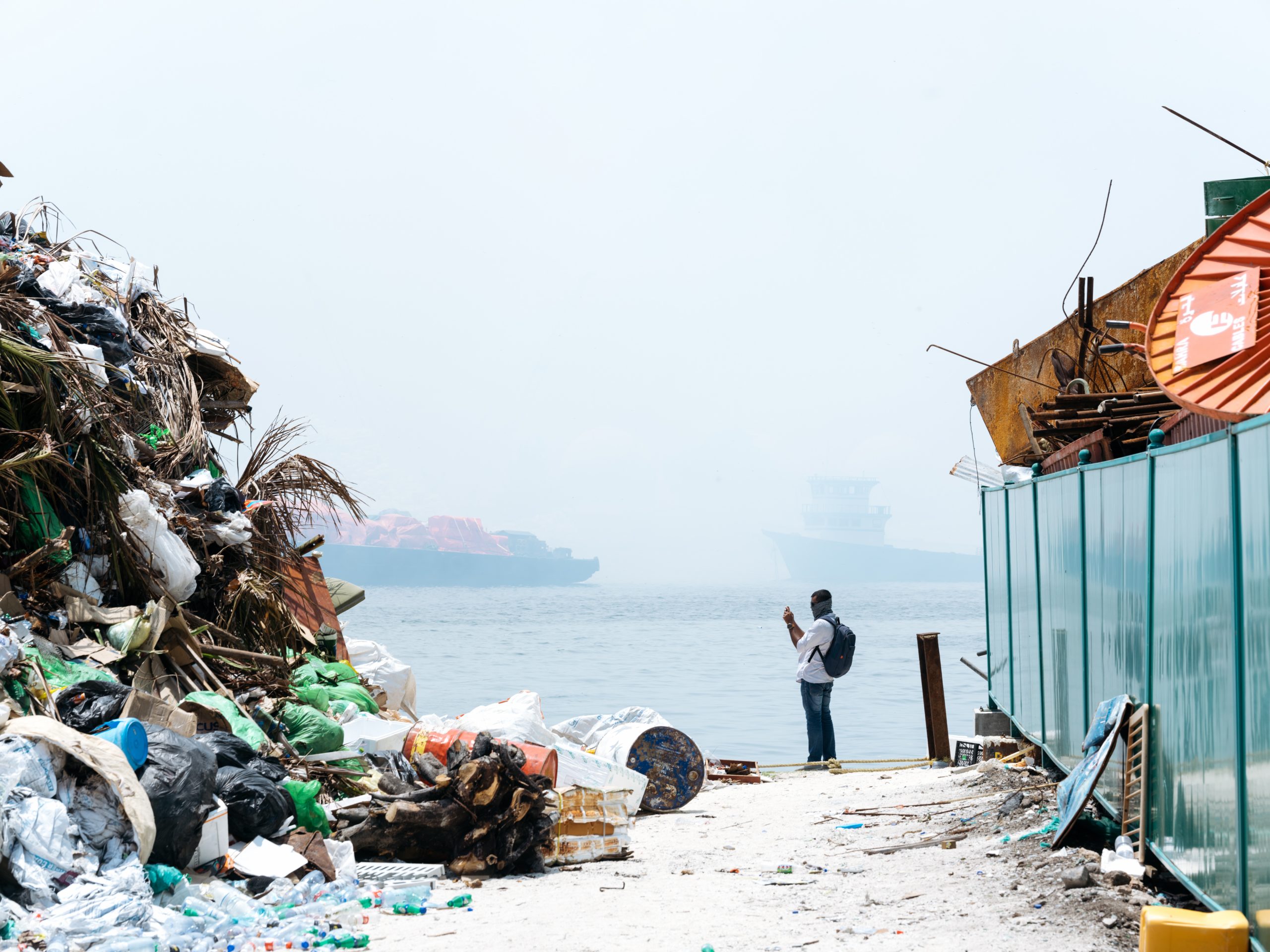
Sustainability initiatives are not confined to resorts, more local tour operators are designing packages with sustainability and the local community as its heart.
The quest for sustainable and more eco friendly measures is not without challenges as the Maldives waste management provision is still in its infancy. Biodegradable or compostable containers often require specialist equipment to facilitate the necessary enzyme activity which are not readily available. Containers and bags which cannot be recycled or composted, are either burnt which adds to smoke emissions or they join the ever-growing waste mountain. This is especially a challenge for local islands or safari boats who have limited means of disposal.
Regulations state that resorts must have a dedicated waste management centre which should have a storage area, treatment facilities such as incinerators, compactors, and bottle crushers. Most organic waste was disposed of at sea. However, that clause in the regulation was repealed in November 2021 due to the inability of people to effectively segregate waste, which resulted in waste that was not biodegradable being thrown into the sea and adding to the unsightly pollution being washed up on beaches, which subsequently attracted flies.
Until the Maldives can implement effective methods to transport, dispose of or recycle its waste it will continue to make its way into the ocean and contribute to the destruction of the environment unless everyone makes a conscious effort to play a positive role in its prevention.
“We still have a really good chance to make things better than they are. They won't get better unless we take the action and inspire others to do the same thing. No one is without power. Everybody has the capacity to do something.” - Dr. Sylvia Earle
Read the previous article: The Blue Economy and Climate Change
Related Posts
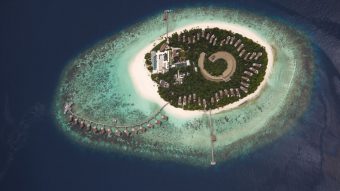
Sustainability Spotlight: Park Hyatt Maldives Hadahaa
[vc_row][vc_column][vc_column_text]Throughout 2017, Hotelier Maldives has been bringing to the spotlight, some of the top properties in Maldives, whose commitment to promoting sustainable tourism practices are nothing short of exemplary. In this last issue for the year, we shine the light on Park Hyatt Hadahaa, a multi-award winning property that has been steadfast in its dedication […]

Power Knot’s LFC Bio-Digester: Safe & cost-effective food waste disposal
[vc_row][vc_column][vc_column_text]The global capacity of waste food produces an estimated 3.3 billion tonnes of CO2 comparable to GHG per year. As one of Earth’s oldest processes, composting is the most effective means of stabilising and converting ecological waste. Power Knot endeavours to aid customers in making intelligent informed choices in implementing programmes to reduce their carbon […]

Jason Lohman, Founder & Managing Director of Bespoke Marketing Global Pte Ltd
[vc_row][vc_column][vc_column_text] Bespoke Marketing Global Pte Ltd specialises in audio branding and was established in 2007 by Founder & Managing Director Jason Lohman. Specialising in On Hold Messaging (OHM), offering a creative and unique experience to inbound callers. Based in Singapore, the company has offices in the U.K., Spain and U.S.A. Globally, the company has over […]
Please register or sign in to continue.
Register and enjoy free, unlimited access to Hotelier Maldives website.
Maldives Tries to Win Back Indian Tourists As Arrivals Fall 40%
Peden Doma Bhutia , Skift
April 16th, 2024 at 9:11 AM EDT
While Maldives enjoys record-breaking arrivals, its tourism companies aren't about to let the Indian market keep falling. They're on a mission to reverse the trend.
Peden Doma Bhutia
The Maldives Association of Travel Agents and Tour Operators is determined to increase Indian arrivals to the island destination and is taking steps to achieve this.
“Indian arrivals to the Maldives have gone down by almost 40%,” said Abdulla Ghiyas, the association’s president, in an exclusive interview with Skift.
In early January, #BoycottMaldives started trending in Indian social media following a diplomatic dispute between the two countries. Indians accused Maldivian politicians of making disparaging remarks against Prime Minister Narendra Modi.
As a result, India, which was the number 2 source market for Maldives, has now fallen to number 6 . India’s share of visitors had been almost 11% – it has shrunk to 5.6%.
Promotions in Indian Cities
Ghiyas said the association will be hosting roadshows in 3 Indian cities in July and confirmed to Skift that one of the cities would be Bengaluru.
The association also plans to engage with Indian social media influencers. “We also want to see how we can work with the tourism board in Maldives as we have partnered with them in the past as well. There are talks that the tourism board is also planning of doing something in India,” Ghiyas said.
At the July roadshows, he said he’s keen to look at cities that have direct connectivity with Maldives.
Ghiyas expressed a desire to have conducted the roadshow earlier, noting that May is when Indian outbound travel peaks. However, he mentioned plans for another round of roadshows towards the end of the year, aiming to include Tier 2 cities. “Even if they lack direct flights to the Maldives, these cities would represent an important market for us,” he said.
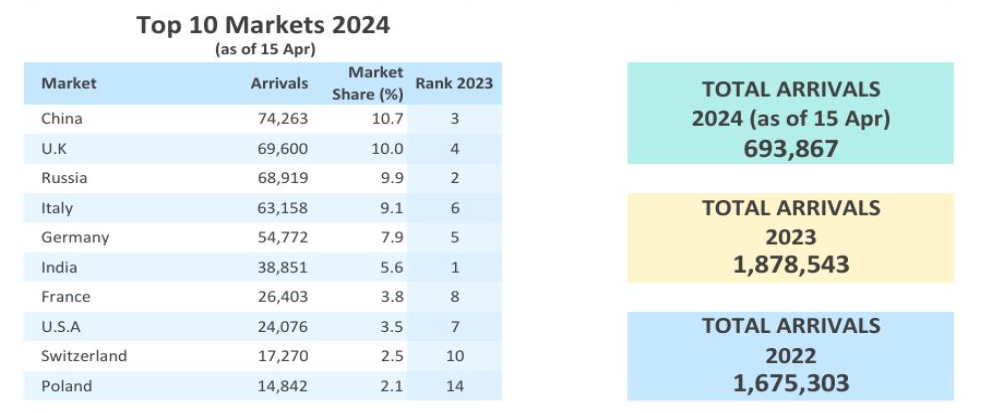
Maldives has so far received (from January 1-April 15) 693,867 tourists, up from 606,395 arrivals for the same period last year, as per the latest data from the Maldives tourism ministry.
China is the top source market for the island destination, followed by UK and Russia.
Between January 1-April 15, almost 39,000 Indians visited Maldives, a decline of almost 40%, compared to the 64,250 arrivals for the same period last year.
“We might not talk immediately about the growth scenario, but I would definitely like to see the 40% decline narrow down,” Ghiyas said.
Can’t Ignore India
While Maldives has experienced record-breaking tourism arrivals so far, Ghiyas said it still needs India. “There are properties and resorts that rely heavily on the Indian market, which have been severely affected. This will hurt us in the long term and that is why we have decided to engage with the India market.”
Aminath Suzan, CEO of Maldives Association of Travel Agents and Tour Operators, pointed to cultural ties, such as similarities in food, language, and pop culture. “We must ensure that unrelated matters do not negatively impact the bond, for which we have dedicated years and built this alliance.”
MATATO Meets with Indian High Commissioner to Foster Tourism Cooperation The Maldives Association of Travel Agents and Tour Operators (MATATO) engaged in a productive meeting with His Excellency Munu Mahawar, the Indian High Commissioner to the Maldives, to explore collaborative… pic.twitter.com/PNXiy3QdVz — MATATO – PATA Maldives Chapter (@matatoMV) April 9, 2024
The association members also recently met with Munu Mahawar, the Indian high commissioner in Maldives, to collaborate closely with his office to boost tourism initiatives.
Dubbing the meeting with Mahawar “positive,” Ghiyas said the high commission has offered assistance to the association. “Once we have a concrete plan, we will definitely follow up with the High Commission and share our plans.”
Skift India Report
The Skift India Report is your go-to newsletter for all news related to travel, tourism, airlines, and hospitality in India.
Have a confidential tip for Skift? Get in touch
Tags: asia monthly , china , india outbound , islands , maldives , social media , tourism marketing
Photo credit: Ritz Carlton Maldives Fari Islands. Fari Islands

IMAGES
COMMENTS
In the Maldives, the tourism industry is touted as the goose that lays golden eggs. According to the World Bank, the Gross Domestic Product (GDP) per capita ballooned from 600 USD in 1985 to over 9,000 USD by 2017. The nation graduated from one of the 20 poorest countries in the world in 1980 to a middle income country by 2017.
The Maldives is a tropical paradise of immaculate white beaches and spectacular coral reefs - but it might be gone by the end of the century. That's the verdict of the country's Minister of ...
The ramifications include increased waste, degradation of sites, and disruptions to local ecosystems. Several reclamation projects in the Maldives, intended for tourism expansion, have inflicted permanent damage on lagoons and their adjacent areas. Catering to the ever-growing tourist demand has sadly compromised the Maldives' delicate ecosystem.
This external shock underscored the fragility of the Maldives' economy, which is heavily dependent on tourism and highlighted the urgent need for economic diversification. Historically, fishing and agriculture were the main economic activities in Maldives. In 1980, both were contributing 35% of GDP together while the tourism contribution was 13%.
Worldwide gross domestic product in 2022 was at about 12,663 USD per capita. GDP on the Maldives, on the other hand, reached USD 11,818 per capita, or 6.19 billion USD for the whole country. The Maldives is currently at number 159 among the international economies and is therefore one of the less significant.
Tourism - the mainstay of the economy. International commercial flights have resumed. The first air bubble arrangement in South Asia was created by India with the Maldives on August 13. Single weekly direct flights of India's national flagship carrier Air India to the Maldives have begun from Thiruvananthapuram, the capital of Kerala state.
Beyond Tourism: The evolving narrative of Maldives' growth. The Covid-19 pandemic brought global tourism and travel to a standstill. Although the health impact of the pandemic has been fairly contained in Maldives, its economic consequences for the tourism-dependent economy have been devastating. To contain the spread of the virus, the ...
The Maldives has come a long way since 1972, when its first resort opened for business. Two hundred and sixty-six foreigners visited that year, staying in rustic huts and marvelling at the gin ...
An island resort in the Maldives Diamonds Thudufushi Beach & Water Villas, a luxury resort on Thudufushi, Ari Atoll in May 2017 Tourism Zone. Tourism is the largest economic industry in the Maldives, as it plays an important role in earning foreign exchange revenues and employing 25,000 people in the tertiary sector of the country. The archipelago of the Maldives is the main source of ...
Therefore, small and tourism-dependent countries can view the pandemic as an opportunity to unleash the potential of tourism and pave the way for sustained growth going forward. Maldives: Setting the Bar High in Tourism. Maldives has been exemplary in its resilience and ability to recover. In 2021, visitor arrivals reached more than 80 percent ...
Overview. At a Glance. Maldives, a country of around 550,000 people dispersed across 185 islands, is an upper-middle-income country with a robust growth trajectory. The economy has maintained its strong growth momentum in 2023 due to rising tourist arrivals, and, with rising tourist arrivals, is expected to maintain a strong growth and poverty ...
This is demonstrated through a case study of the evolution of tourism in the Maldives, a luxury tourism destination where the government has followed a consistent policy of 'quality tourism' that has often been cited as a prime example of sustainable tourism. However, recently concerns have been raised about environmental degradation, human ...
Male' Maldives, 18th October 2023 - The Maldives Association for Travel Agents and Tour Operators (MATATO) unveiled the outcomes of a recent survey, shedding light on the precarious state of the nation's tourism industry.Abdulla Giyas, the President of MATATO, presented the findings of the survey during a press conference.
5. The Stunning Sunsets: Watching the sunset is a popular activity in the Maldives, and for good reason. The sky takes on a beautiful orange hue as the sun dips below the horizon, creating a magical backdrop for your evening activities. 6. The Wonderful Weather: The weather in the Maldives is warm and sunny year-round.
The Maldives have something of a Catch-22 relationship with tourism. The islands are heavily dependent on the industry, which is responsible for 30 percent of the Maldives' GDP. Yet air travel is a major contributory factor to the carbon emissions that are driving the climate crisis and threatening the Maldives' existence.
There are roughly 200 inhabited local islands in the Maldives, including Malé, the densely-populated capital. Around 166 are resort islands, with 29 more islands allocated for development in 2019 and 14 more in 2023. Tourism leases can last 100 years, so these are long term developments. The enormous whale sharks, gentle giants, are one of the ...
Maldives is a middle income country with GDP per capita (2010 est.) of $4,770 and inflation is 4.7%. In recent years. The country greatly benefitted from tourism, which brings around $600 million ...
Ms.Ms. AminathNuzlaHameed Ministry of Tourism. Introduction. ∗Maldives is a small island nation, having 90 percent of its territory covered in water. The country comprises of 1192 low‐lying islands which make up less than 2 percent of the total area. ItsIts population of 338, 442 (2012) inhabits 192 of its 1,192 islands.
Atoll households also spent significantly more on shopping during their domestic trips (see Figure 12). Based on the average spending per household surveyed, total annual expenditure on domestic tourism in the Maldives is estimated at MVR692 million. Figure 11. Annual Expenditure on Domestic Tourism.
3 Disadvantages of Living in the Maldives. After learning the seven advantages of living in the Maldives, you might wonder what downsides this gorgeous country could possibly have. Most of these disadvantages are the result of adjusting to a new location. ... Islands with tourism and resorts look pretty polished, so if that's your first ...
The Maldives is an 820-kilometre-long chain of nearly 1,200 islands dotting the Indian Ocean. The nation has become one of the most popular luxury tourism destinations in the world because of its ...
The Disadvantages of Tourism- To Conclude. As you can see, there are unfortunately many disadvantages of tourism. However, just because these disadvantages of tourism currently exist, doesn't mean that have to continue. With adequate planning, policies and governance and with sustainability principles and long-term planning at the forefront ...
Sustainable Tourism in Maldives. June 9, 2022 by Janet Smailes. Sustainability and Climate Change are now a key focus in the travel and tourism industry becoming an intrinsic part of the post pandemic tourism rebound. More than 300 tourism stakeholders recently signed up to the Glasgow Declaration on Climate which recognizes the urgent need for ...
Source: Ministry of Tourism, Maldives. Involvement Phase, 1972 - 1983 Tourism statistics coupled with interviews with industry experts provide crucial facts about the evolution of the tourism sector in the Maldives. At the initial stage, the major constraints for the industry were poor transport and the difficulty in finding skilled workers.
Maldives has so far received (from January 1-April 15) 693,867 tourists, up from 606,395 arrivals for the same period last year, as per the latest data from the Maldives tourism ministry.